Hair Removal Combining Saliency, Shape and Color
Abstract
Featured Application
Abstract
1. Introduction
2. The Proposed Method
- Step 1.
- Size reduction—The first step is devoted to limit the computation burden of the successive steps by reducing the size of the input image with a scale factor s equal to the ratio of a fixed value, say Maxdim, and the number of columns. To perform this, we resort to the classical and most common bicubic downsampling, implemented by the Matlab command imresize with bicubic option and scale factor s. The size reduction step is an optional but highly recommended operation since it significantly limits the computation time.
- Step 2.
- Pseudo-Hair detection—This step is based on top-hat transformation, i.e., a morphological operator capable of extracting small elements and details from a grayscale image, commonly used for feature extraction, background equalization, and other enhancement operations. There are two types of transformation: the white top-hat transformation, defined as the difference between the original image and its aperture by a structuring element, and the black top-hat transformation (or bottom-hat transformation), defined dually as the difference between the closure by a structuring element and the original image [32,33]. Following [19,34], to obtain the binarized version HR initially containing the pseudo-hair components, we apply a bottom-hat filter in the red band R of the RGB image and then the Otsu threshold method [35] by the Matlab command imbinarize. Then, if HR is not empty, the actual hair regions are determined during the successive steps 3–5.
- Step 3.
- Border and corner component detection—The border components are detected based on their saliency and proximity to the image frame, by applying the following process, named called border detection, already used in [14,15]. The saliency map (SM) with well-defined boundaries of salient objects is computed by the method proposed in [36]. Successively, SM is enhanced by increasing the contrast in the following way: the values of the input intensity image are mapped to new values obtained by saturating the bottom 1% and the top 1% of all pixel values, by the Matlab command imadjust. Then, the saliency map SM is binarized by assigning to the foreground all pixels with a saliency value greater than the average saliency value. The connected components of SM including pixels of the image frame are considered as border components and stored in the bidimensional array, named BC.
- Step 4.
- Hair object detection—Preliminarily, the no-hair regions are detected and stored in the bidimensional array, named NR, as follows. NR is initially computed as the product S.*V and binarized by the Otsu method. Then, the salient pixels not belonging to HR and BC are included in NR, the pseudo-hair regions currently detected in HR are removed from NR, and small holes in NR are filled. Successively, if NR has a significant extension (area), the detected no-hair regions are removed from HR. If the current HR is not empty, border components are suitably considered and possibly removed from HR taking also into account the gray version of the input image Ig and a fixed gray value, say Δ, indicating a minimum reference gray value for the hair component. Finally, corner components and eventual remaining components corresponding to colored disks are eliminated from HR.
| Step 4. Hair object detection |
| % No-hair regions detection NR = S. *V; % Initial no-hair regions construction and storing in NR NR = imbinarize(NR, graythresh (NR)) % Otsu binarization |
| NR(SM > 0 & HR == 0 & BC == 0) = 1; % insertion in NR of salient pixel not belonging to HR and BC |
| NR (HR > 0) = 0; % pseudo-hair elimination from NR |
| NR = imfill(NR,’holes’); % holes filling % end of no-hair regions detection |
| if (area(NR) is significant) |
| HR(NR > 0) = 0; % no-hair regions removal from HR |
| HR = imfill(HR,’holes’); % holes filling |
| if (HR is not empty) |
| if (BC is not empty) % border and corner components management |
| NB = BC; % copy of BC |
| NB(NR > 0 & Ig > Δ) =0 ; % generation of NB without no-hair regions and too dark regions |
| HR(NB >= 0 & SM > 0) % elimination of salient pixels of NB from HR |
| CR = (BC > 0 & NB > 0) % common regions to BC and NB |
| HR(CR > 0) = 0 % elimination from HR of common regions of BC and NB |
| CR(CR > 0 & CC > 0) = 0; % corner regions elimination from CR |
| BN = border_detection (CR); % border components detection in CR (as done in step 3) |
| if (BN is not empty) |
| HR(BN > 0 & Ig > Δ) = 0; % elimination of clear border regions of CR from HR |
| end |
| end |
| HR(NR > 0 & HR > 0 | (BC > 0 & Ig > Δ)) = 0; % colored disk and clear border component removal |
| end |
| end |
- Step 5.
- Inpainting and rescaling—If HR is empty, the image is considered hairless; otherwise, the reconstruction process is applied. After a preliminary enlargement of HR by n steps of dilation, the inpainting is carried out by calling the Matlab function regionfill on each image channel separately, by using HR as hair-mask and then joining the resulting channels. If the size reduction step has been performed, a scaling is newly applied using the Matlab function imresize with the bicubic option. In Figure 3e, examples of the resulting image are given.
3. Experimental Results
3.1. Datasets
3.2. Qualitative Evaluation
- (a)
- We check whether, in most cases, the hair determination is successful or not, i.e., that the images are re-confirmed as belonging to H-data and NH-data, respectively. This allows us to determine for the different considered methods how much the resulting sets belonging to H-data or NH-data are equal to the initial ones.
- (b)
- We verify if the appearance of the hairless resulting image is, according to human subjective judgment, compatible with a hairless and good quality version of it. Moreover, we test whether the presence of the hair can preclude or alter a subsequent step of skin lesion segmentation.
- (c)
- We visually compare the obtained results by the proposed method and those directly available in [37] or by the available implementation of Lee and Xie on H13GAN-data, H13Sim-data, HSim-data, and H-data to determine their overall performance.
3.3. Quantitative Evaluation
- -
- -
- area of the detected hair regions;
- -
- true/false discovery rate (see the definition in Section 3.3.3).
3.3.1. Quantitative Evaluation Based on Quality Measures
3.3.2. Quantitative Evaluation Based on the Area of the Detected Hair Regions
3.3.3. Quantitative Evaluation in Terms of True/False Discovery Rate
4. Discussion and Conclusions
Funding
Institutional Review Board Statement
Informed Consent Statement
Data Availability Statement
Conflicts of Interest
References
- Okur, E.; Turkan, M. A survey on automated melanoma detection. Eng. Appl. Artif. Intell. 2018, 73, 50–67. [Google Scholar] [CrossRef]
- Oliveira, R.B.; Papa, J.P.; Pereira, A.S.; Tavares, J.M.R.S. Computational methods for pigmented skin lesion classification in images: Review and future trends. Neural Comput. Appl. 2018, 29, 613–636. [Google Scholar] [CrossRef]
- Masood, A.; Jumaily, A.A. A Computer Aided Diagnostic Support System for Skin Cancer: A Review of Techniques and Algorithms. Int. J. Biom. Imag. 2013. [Google Scholar] [CrossRef] [PubMed]
- Vocaturo, E.; Zumpano, E.; Veltri, P. Image pre-processing in computer vision systems for melanoma detection. In Proceedings of the 2018 IEEE International Conference on Bioinformatics and Biomedicine (BIBM), Madrid, Spain, 6 December 2018; pp. 2117–2124. [Google Scholar]
- Kavitha, N.; Vayelapelli, M. A Study on Pre-Processing Techniques for Automated Skin Cancer Detection. Smart Technologies in Data Science and Communication; Fiaidhi, J., Bhattacharyya, D., Rao, N., Eds.; Lecture Notes in Networks and Systems; Springer: Berlin/Heidelberg, Germany, 2020; Volume 105, pp. 145–153. [Google Scholar]
- Michailovich, O.V.; Tannenbaum, A. Despeckling of medical ultrasound images. IEEE Trans. Ultras. Ferroelect. Freq. Control 2006, 53, 64–78. [Google Scholar] [CrossRef] [PubMed]
- Ramella, G.; Sanniti di Baja, G. A new technique for color quantization based on histogram analysis and clustering. Int. J. Patt. Recog. Art. Intell. 2013, 27, 13600069. [Google Scholar] [CrossRef]
- Bruni, V.; Ramella, G.; Vitulano, D. Automatic Perceptual Color Quantization of Dermoscopic Images. In VISAPP 2015; Scitepress Science and Technology Publications: Setúbal, Portugal, 2015; Volume 1, pp. 323–330. [Google Scholar]
- Ramella, G.; Sanniti di Baja, G. A new method for color quantization. In Proceedings of the 12th International Conference on Signal Image Technology & Internet-Based Systems—SITIS 2016, Naples, Italy, 28 November–1 December 2016; pp. 1–6. [Google Scholar]
- Bruni, V.; Ramella, G.; Vitulano, D. Perceptual-Based Color Quantization. Image Analysis and Processing—ICIAP 2017; Lecture Notes in Computer Science 10484; Springer: Berlin/Heidelberg, Germany, 2017; pp. 671–681. [Google Scholar]
- Premaladha, J.; Lakshmi Priya, M.; Sujitha, S.; Ravichandran, K.S. A Survey on Color Image Segmentation Techniques for Melanoma Diagnosis. Indian J. Sci. Technol. 2015, 8, IPL0265. [Google Scholar]
- Ramella, G.; Sanniti di Baja, G. Image Segmentation Based on Representative Colors and Region Merging in Pattern Recognition; Lecture Notes in Computer Science 7914; Springer: Berlin/Heidelberg, Germany, 2013; pp. 175–184. [Google Scholar]
- Ramella, G.; Sanniti di Baja, G. From color quantization to image segmentation. In Proceedings of the 2016 12th International Conference on Signal-Image Technology & Internet-Based Systems (SITIS), Naples, Italy, 28 November–1 December 2016; IEEE: Piscataway Township, NJ, USA, 2016; pp. 798–804. [Google Scholar]
- Ramella, G. Automatic Skin Lesion Segmentation based on Saliency and Color. In VISAPP 2020; Scitepress Science and Technology Publications: Setúbal, Portugal, 2020; Volume 4, pp. 452–459. [Google Scholar]
- Ramella, G. Saliency-based segmentation of dermoscopic images using color information. arXiv 2020, arXiv:2011.13179. [Google Scholar]
- Celebi, M.E.; Wen, Q.; Iyatomi, H.; Shimizu, K.; Zhou, H.; Schaefer, G. A state-of-the-art survey on lesion border detection in dermoscopy images. In Dermoscopy Image Analysis; Celebi, M.E., Mendonca, T., Marques, J.S., Eds.; CRC Press: Boca Raton, FL, USA, 2016; pp. 97–129. [Google Scholar]
- Talavera-Martinez, L.; Bibiloni, P.; Gonzalez-Hidalgo, M. Comparative Study of Dermoscopic Hair Removal Methods. In Proceedings of the ECCOMAS Thematic Conference on Computational Vision and Medical Image Processing, Porto, Portugal, 16–18 October 2019; Springer: Berlin/Heidelberg, Germany, 2019. [Google Scholar]
- Lee, T.; Ng, V.; Gallagher, R.; Coldman, A.; McLean, D. Dullrazor: A software approach to hair removal from images. Comput. Biol. Med. 1997, 27, 533–543. [Google Scholar] [CrossRef]
- Xie, F.-Y.; Qin, S.-Y.; Jiang, Z.-G.; Meng, R.-S. PDE-based unsupervised repair of hair-occluded information in dermoscopy images of melanoma. Comput. Med. Imaging Graph. 2009, 33, 275–282. [Google Scholar] [CrossRef]
- Abbas, Q.; Celebi, M.E.; Fondón García, I. Hair removal methods: A comparative study for dermoscopy images. Biomed. Signal Process. Control. 2011, 6, 395–404. [Google Scholar] [CrossRef]
- Huang, A.; Kwan, S.-Y.; Chang, W.-Y.; Liu, M.-Y.; Chi, M.-H.; Chen, G.-S. A robust hair segmentation and removal approach for clinical images of skin lesions. In Proceedings of the 35th Annual International Conference of the IEEE Engineering in Medicine and Biology Society (EMBS), Osaka, Japan, 3–7 July 2013; pp. 3315–3318. [Google Scholar]
- Toossi MT, B.; Pourreza, H.R.; Zare, H.; Sigari, M.H.; Layegh, P.; Azimi, A. An effective hair removal algorithm for dermoscopy images. Skin Res. Technol. 2013, 19, 230–235. [Google Scholar] [CrossRef] [PubMed]
- Bibiloni, P.; Gonzàlez-Hidalgo, M.; Massanet, S. Skin Hair Removal in Dermoscopic Images Using Soft Color Morphology. In AIME 2017; Lecture Notes in Artificial Intelligence 10259; Springer: Berlin/Heidelberg, Germany, 2017; pp. 322–326. [Google Scholar]
- Koehoorn, J.; Sobiecki, A.; Rauber, P.; Jalba, A.; Telea, A. Efficient and Effective Automated Digital Hair Removal from Dermoscopy Images. Math. Morphol. Theory Appl. 2016, 1, 1–17. [Google Scholar]
- Zaqout, I.S. An efficient block-based algorithm for hair removal in dermoscopic images. Comput. Optics. 2017, 41, 521–527. [Google Scholar] [CrossRef]
- Attia, M.; Hossny, M.; Zhou, H.; Nahavandi, S.; Asadi, H.; Yazdabadi, A. Digital hair segmentation using hybrid convolutional and recurrent neural networks architecture. Comput. Methods Programs Biomed. 2019, 177, 17–30. [Google Scholar] [CrossRef] [PubMed]
- Talavera-Martınez, L.; Bibiloni, P.; Gonzalez-Hidalgo, M. An Encoder-Decoder CNN for Hair Removal in Dermoscopic Images. arXiv 2020, arXiv:2010.05013v1. [Google Scholar]
- Mendonca, T.; Ferreira, P.M.; Marques, J.S.; Marcal, A.R.; Rozeira, J. PH2–A public database for the analysis of dermoscopic images. In Dermoscopy Image Analysis; Celebi, M.E., Mendonca, T., Marques, J.S., Eds.; CRC Press: Boca Raton, FL, USA, 2015; pp. 419–439. [Google Scholar]
- ISIC 2016. ISIC Archive: The International Skin Imaging Collaboration: Melanoma Project, ISIC. Available online: https://isic-archive.com/# (accessed on 5 January 2016).
- Itti, L.; Koch, C.; Niebur, E. A model of saliency-based visual attention for rapid scene analysis. IEEE Trans. Patt. Anal. Mach. Intell. 1998, 20, 1254–1259. [Google Scholar] [CrossRef]
- Haralick, R.; Sternberg, S.R.; Huang, X. Image Analysis Using Mathematical Morphology. IEEE Trans. PAMI 1987, 4, 532–550. [Google Scholar] [CrossRef]
- Soille, P. Morphological Image Analysis: Principles and Applications; Springer: Berlin/Heidelberg, Germany, 2004. [Google Scholar]
- Serra, J.; Vincent, L. An Overview of Morphological Filtering. Circuits Systems Signal Process. 1992, 11, 47–108. [Google Scholar] [CrossRef]
- Guarracino, M.R.; Maddalena, L. SDI+: A Novel Algorithm for Segmenting Dermoscopic Images. IEEE J. Biomed. Health Inf. 2019, 23, 481–488. [Google Scholar] [CrossRef]
- Otsu, N. A Threshold Selection Method from Gray-Level Histograms. IEEE Trans. Systems Man Cybern. 1979, 9, 62–66. [Google Scholar] [CrossRef]
- Achanta, R.; Hemami, S.; Estrada, F.; Susstrunk, S. Frequency-tuned salient region detection. In Proceedings of the 2009 IEEE Conference on Computer Vision and Pattern Recognition, Miami, FL, USA, 20–25 June 2009; IEEE: Piscataway Township, NJ, USA, 2009; pp. 1597–1604. [Google Scholar]
- Dermaweb. Available online: http://dermaweb.uib.es/ (accessed on 26 November 2020).
- Attia, M.; Hossny, M.; Zhou, H.; Yazdabadi, A.; Asadi, H.; Nahavandi, S. Realistic Hair Simulator for Skin lesion Images Using Conditional Generative Adversarial Network. Preprints 2018, 2018100756. [Google Scholar] [CrossRef]
- HairSim by Hengameh Mirzaalian. Available online: http://creativecommons.org/licenses/by-nc-sa/3.0/deed.en_US (accessed on 26 November 2020).
- Mitsa, T.; Varkur, K.L. Evaluation of contrast sensitivity functions for the formulation of quality measures incorporated in halftoning algorithms. In Proceedings of the IEEE International Conference on Acoustics, Speech, and Signal Processing (ICASSP), Minneapolis, MN, USA, 27–30 April 1993; pp. 301–304. [Google Scholar]
- Ramella, G. Evaluation of quality measures for color quantization. arXiv 2020, arXiv:2011.12652. [Google Scholar]
- Chandler, D.M. Seven Challenges in Image Quality Assessment: Past, Present, and Future Research. ISRN Signal Process. 2013, 2013, 1–53. [Google Scholar] [CrossRef]
- Lee, D.; Plataniotis, K.N. Towards a Full-Reference Quality Assessment for Color Images Using Directional Statistics. IEEE Trans. Image Process. 2015, 24, 3950–3965. [Google Scholar] [CrossRef] [PubMed]
- Lin, W.; Kuo, C.-C.J. Perceptual visual quality metrics: A survey. J. Vis. Commun. Image Represent. 2011, 22, 297–312. [Google Scholar] [CrossRef]
- Liu, M.; Gu, K.; Zhai, G.; Le Callet, P.; Zhang, W. Perceptual Reduced-Reference Visual Quality Assessment for Contrast Alteration. IEEE Trans. Broadcast. 2016, 63, 71–81. [Google Scholar] [CrossRef]

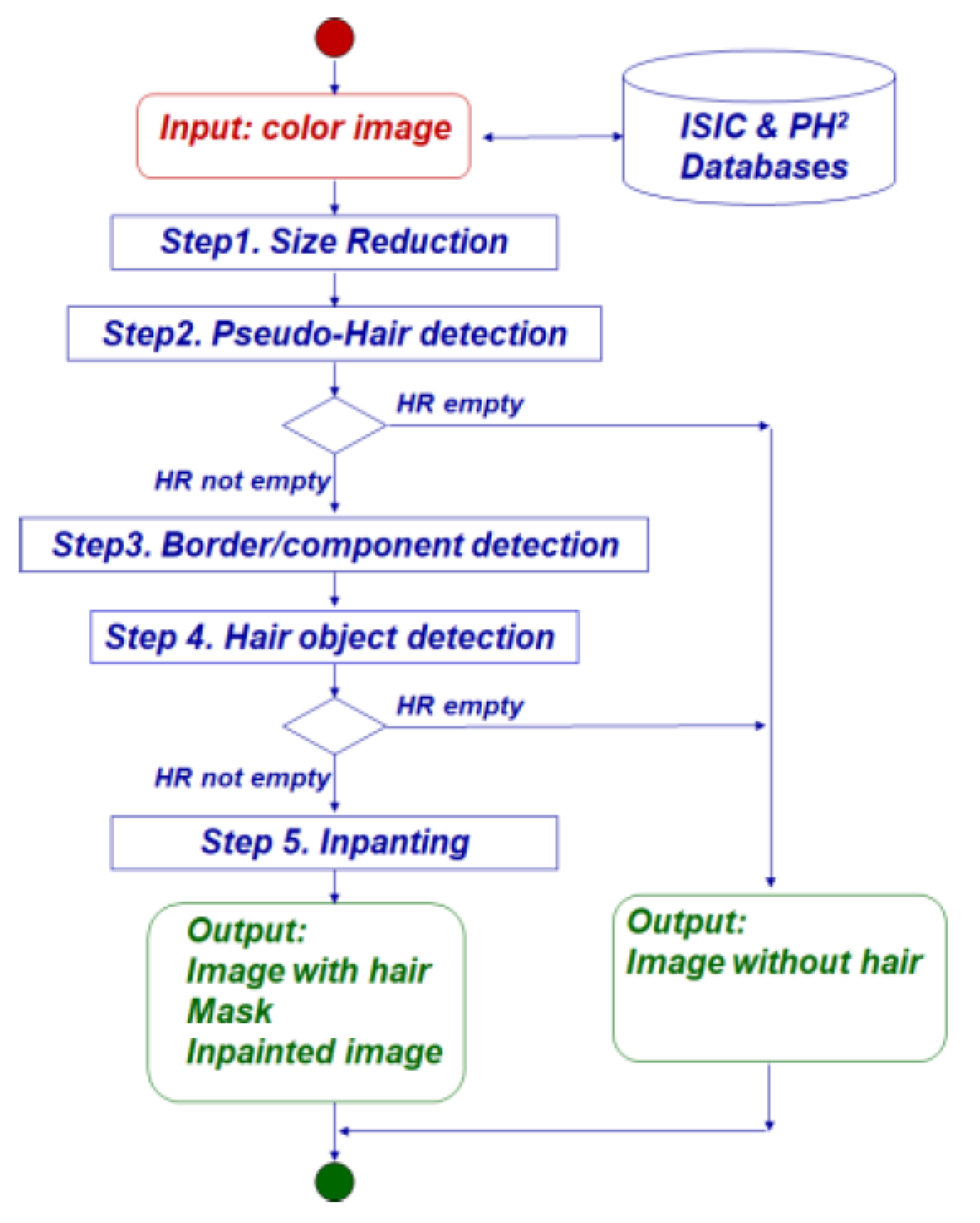
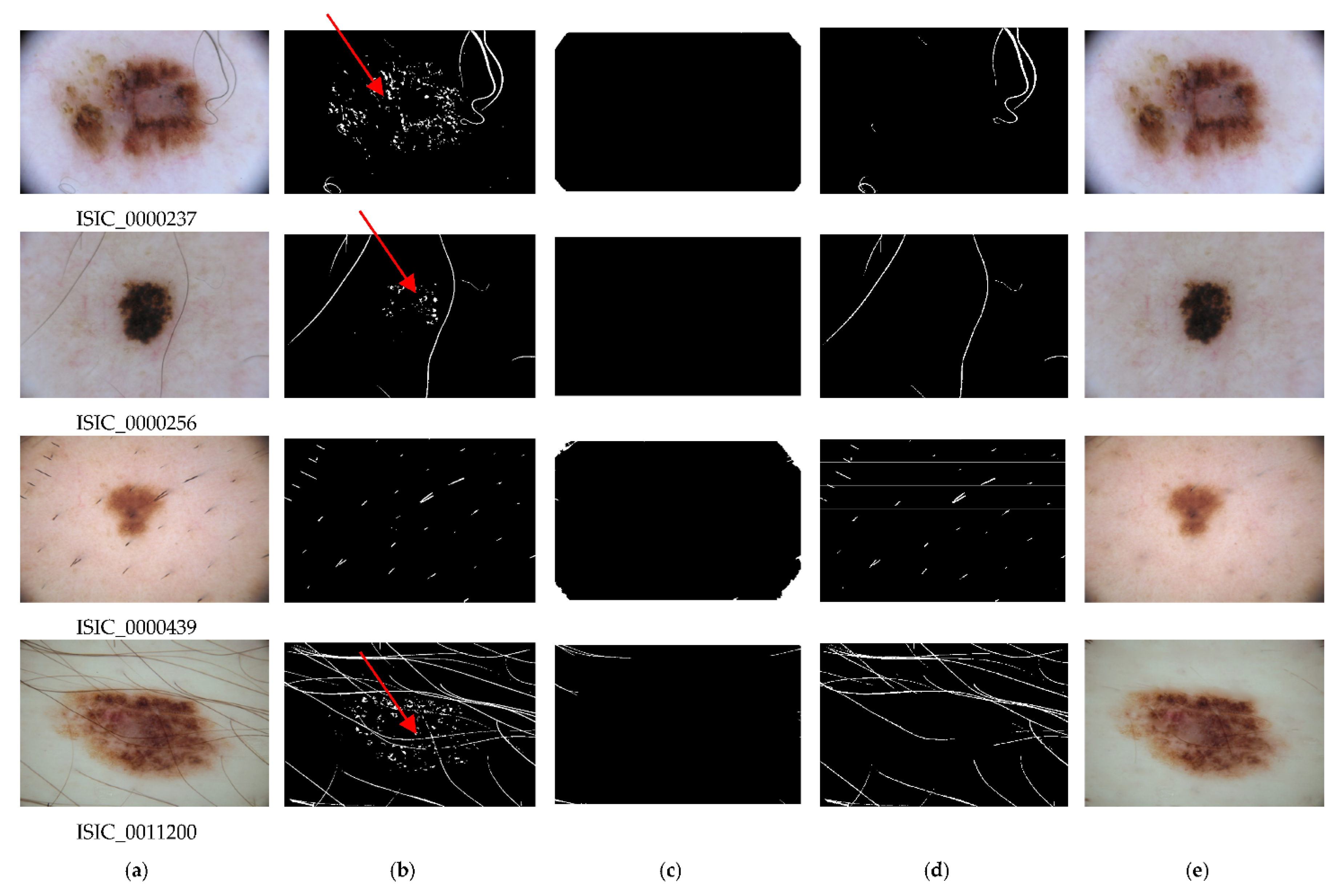




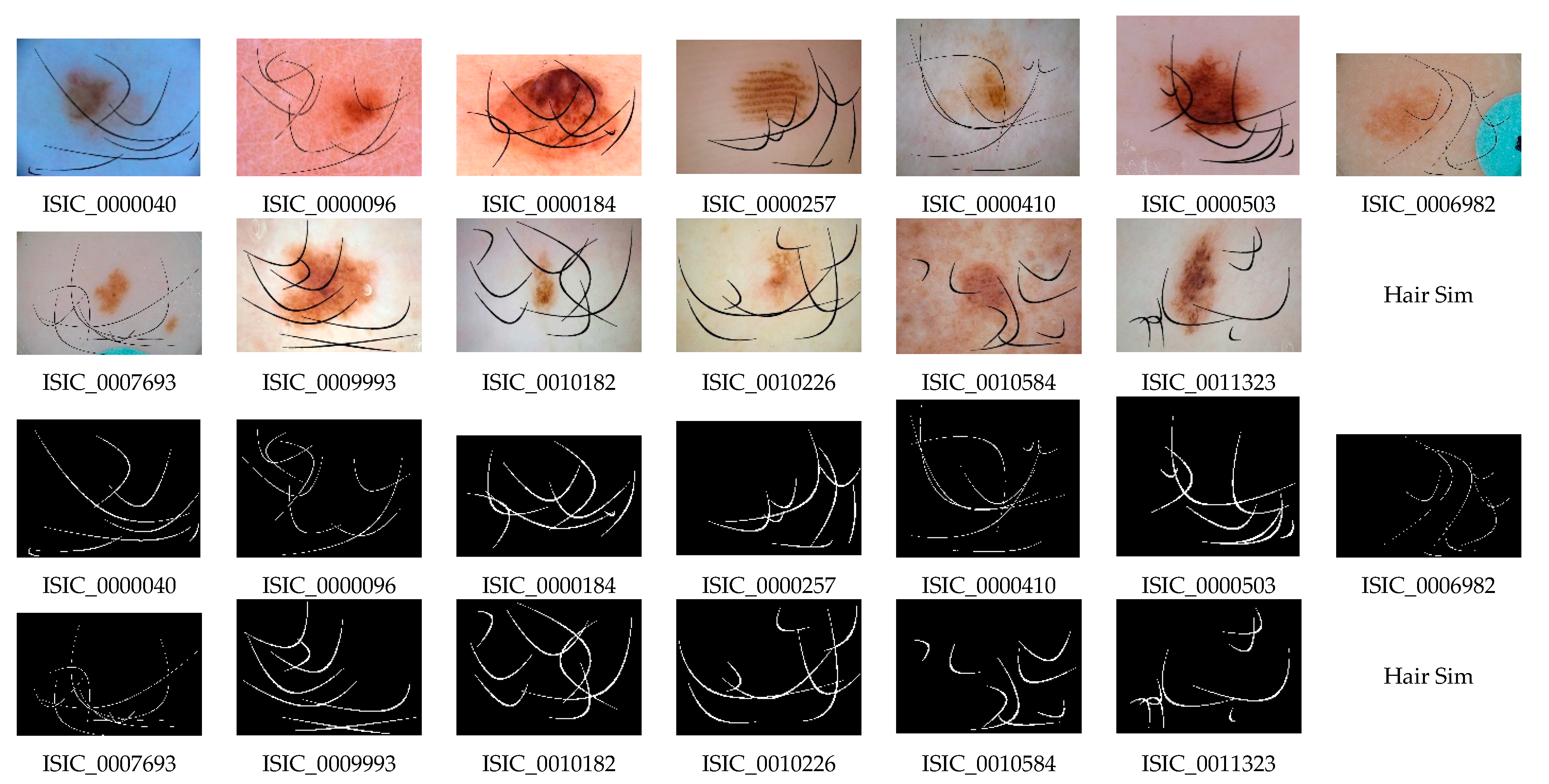

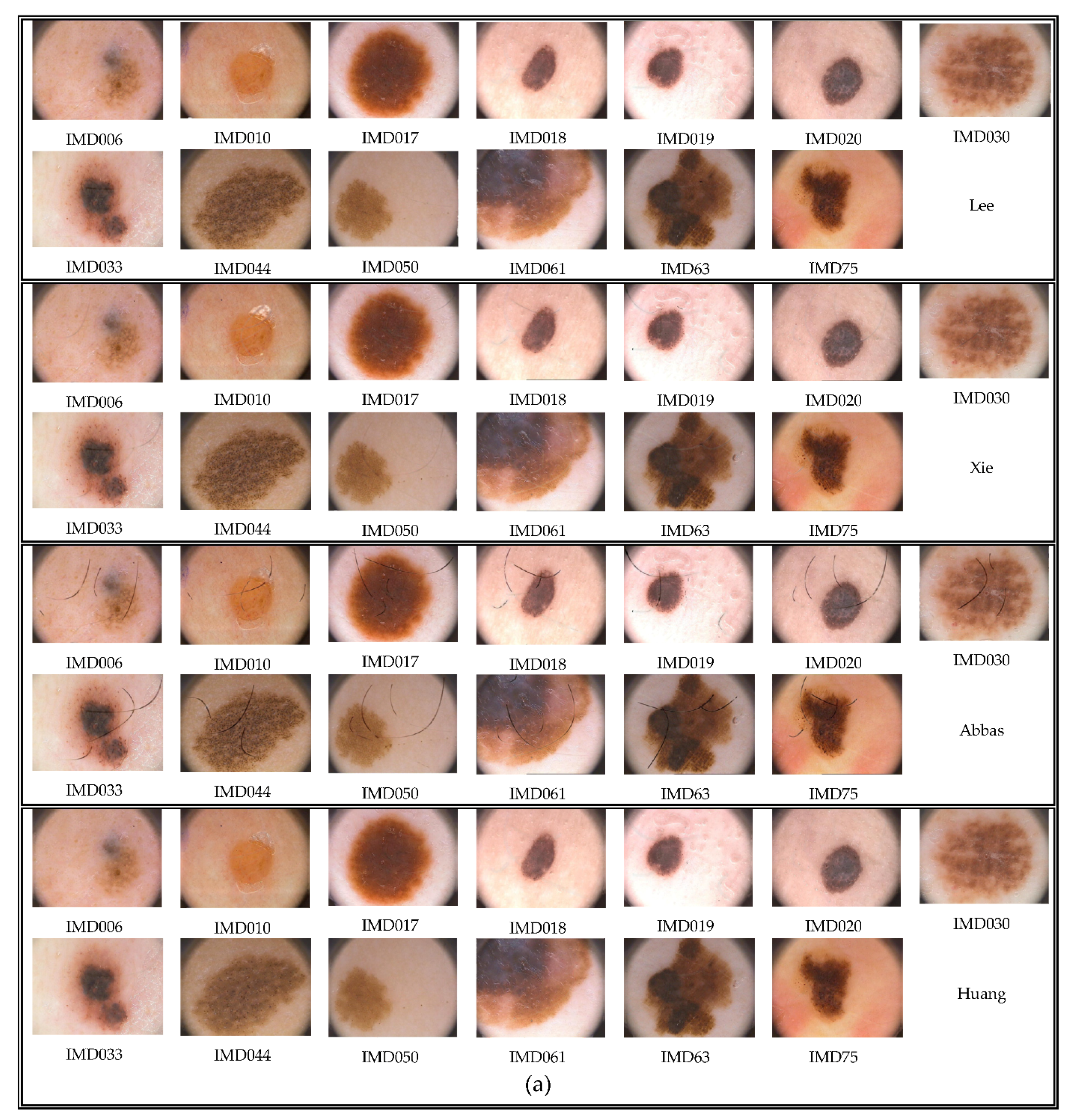
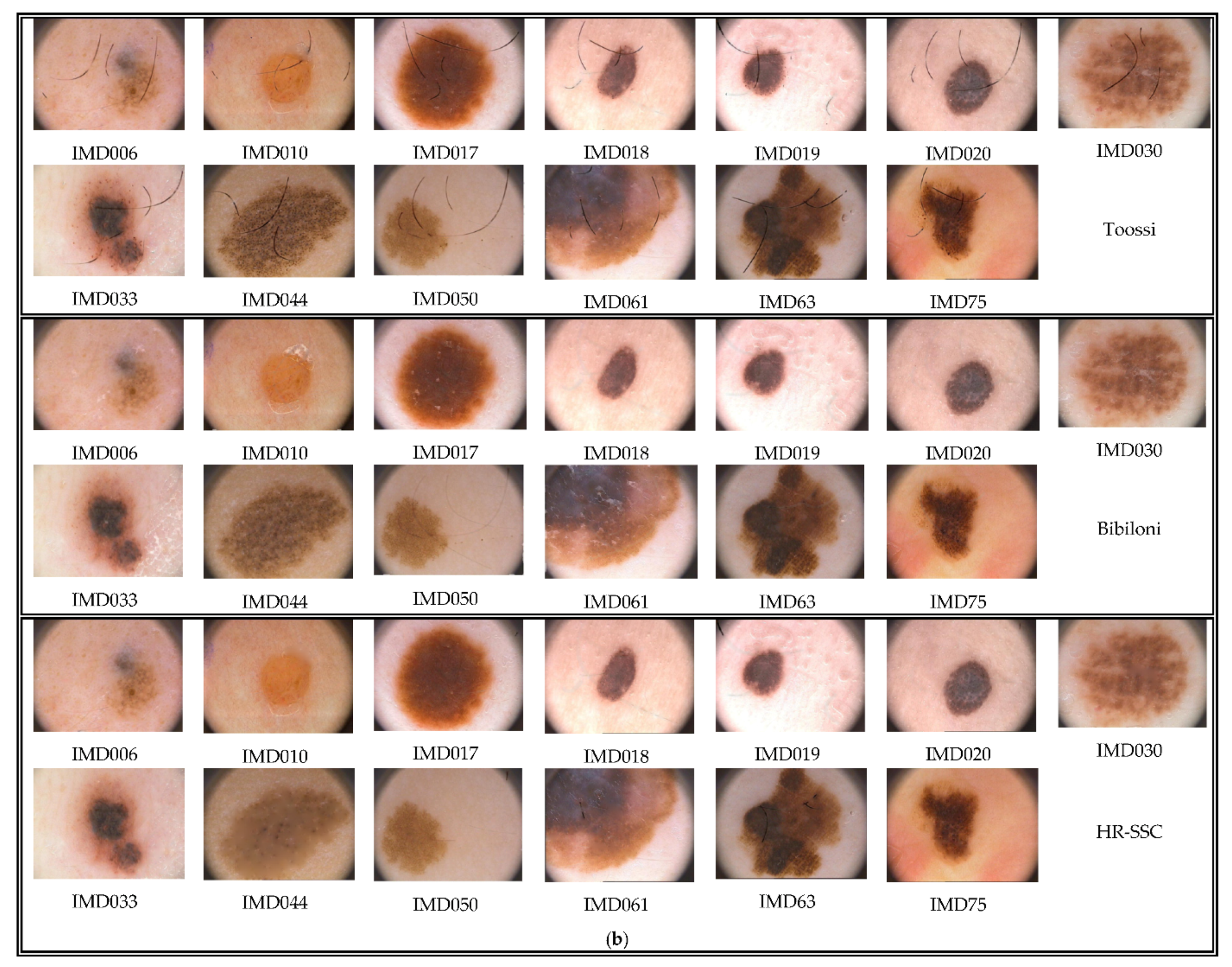
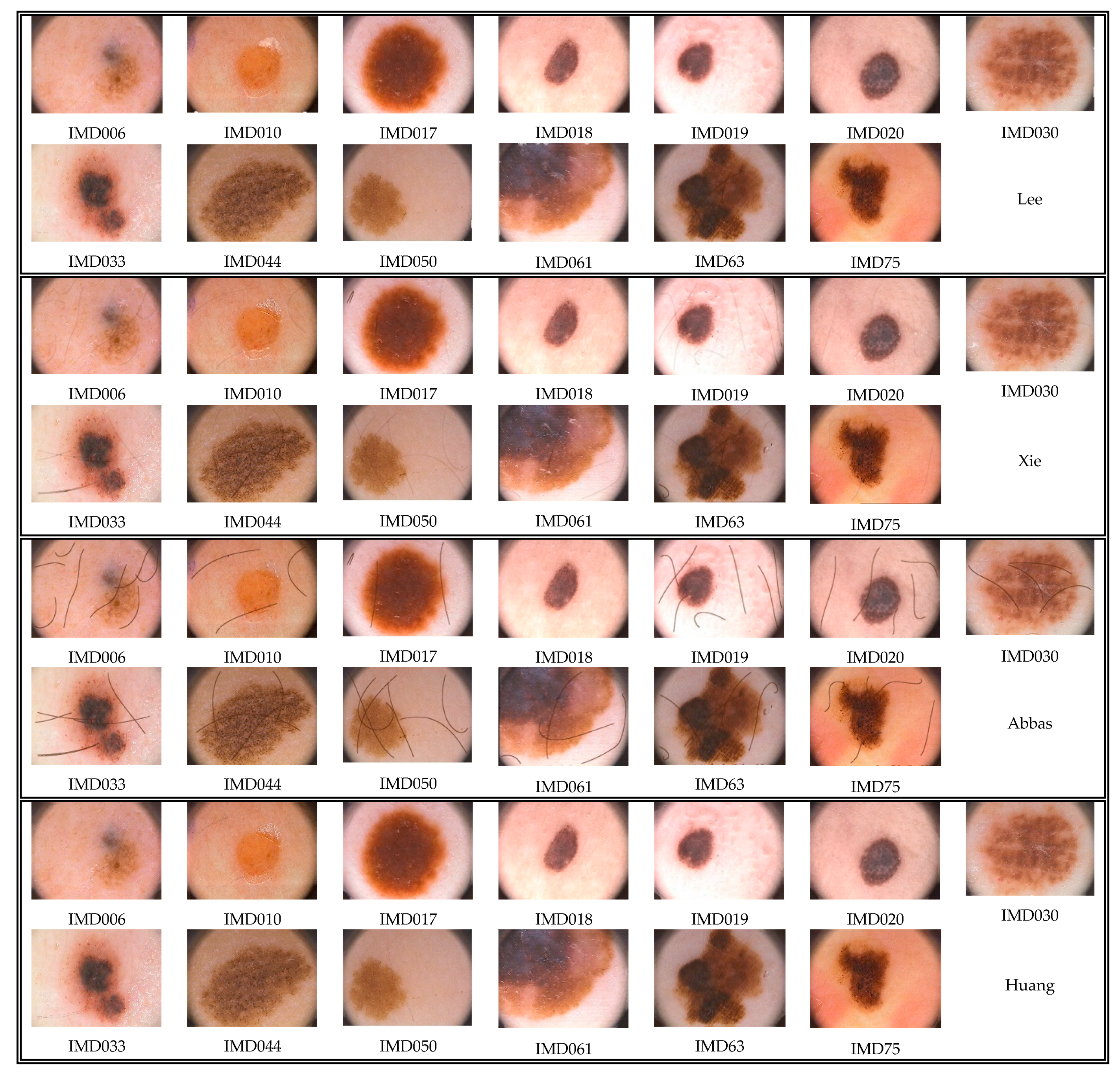
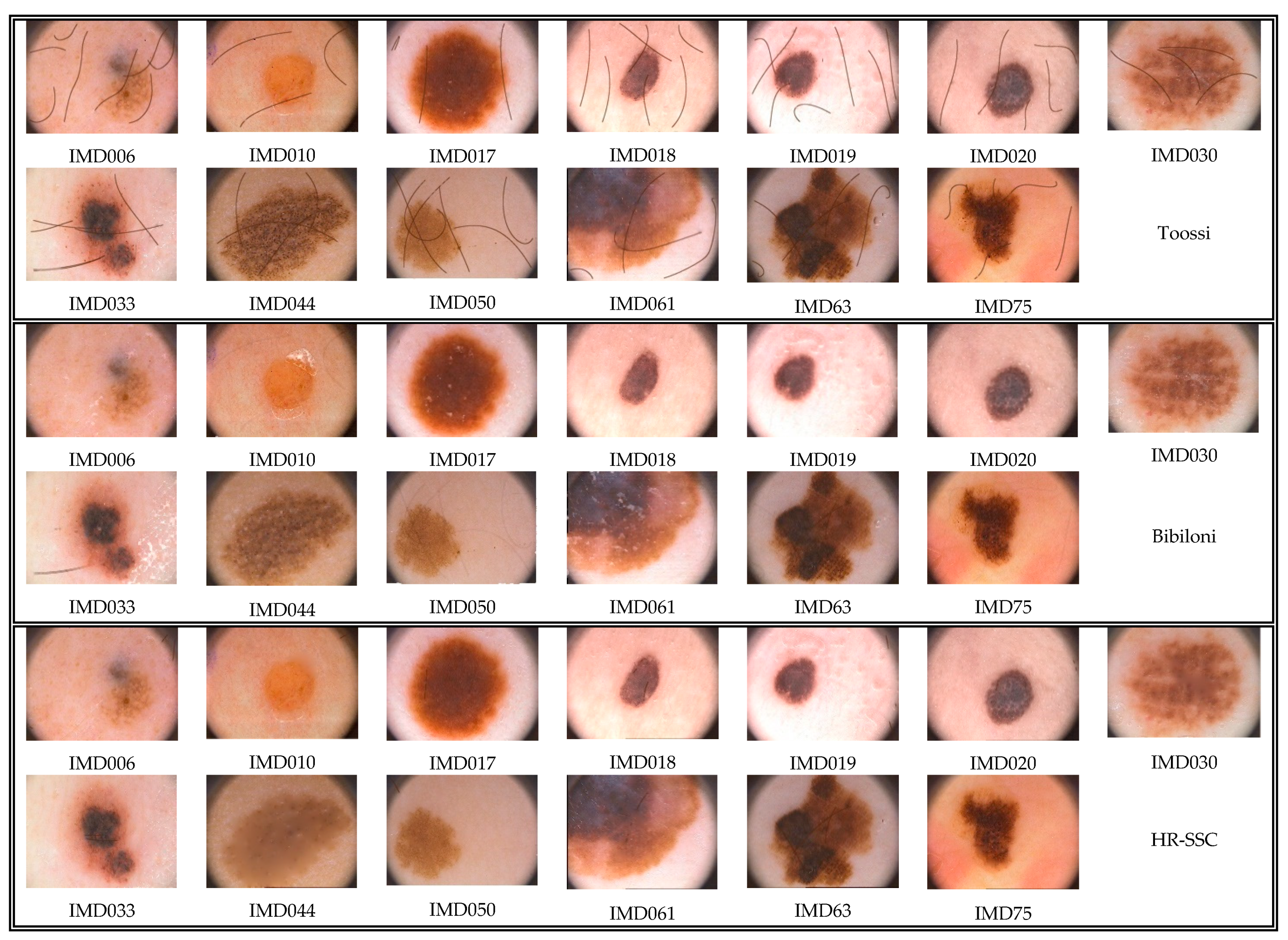
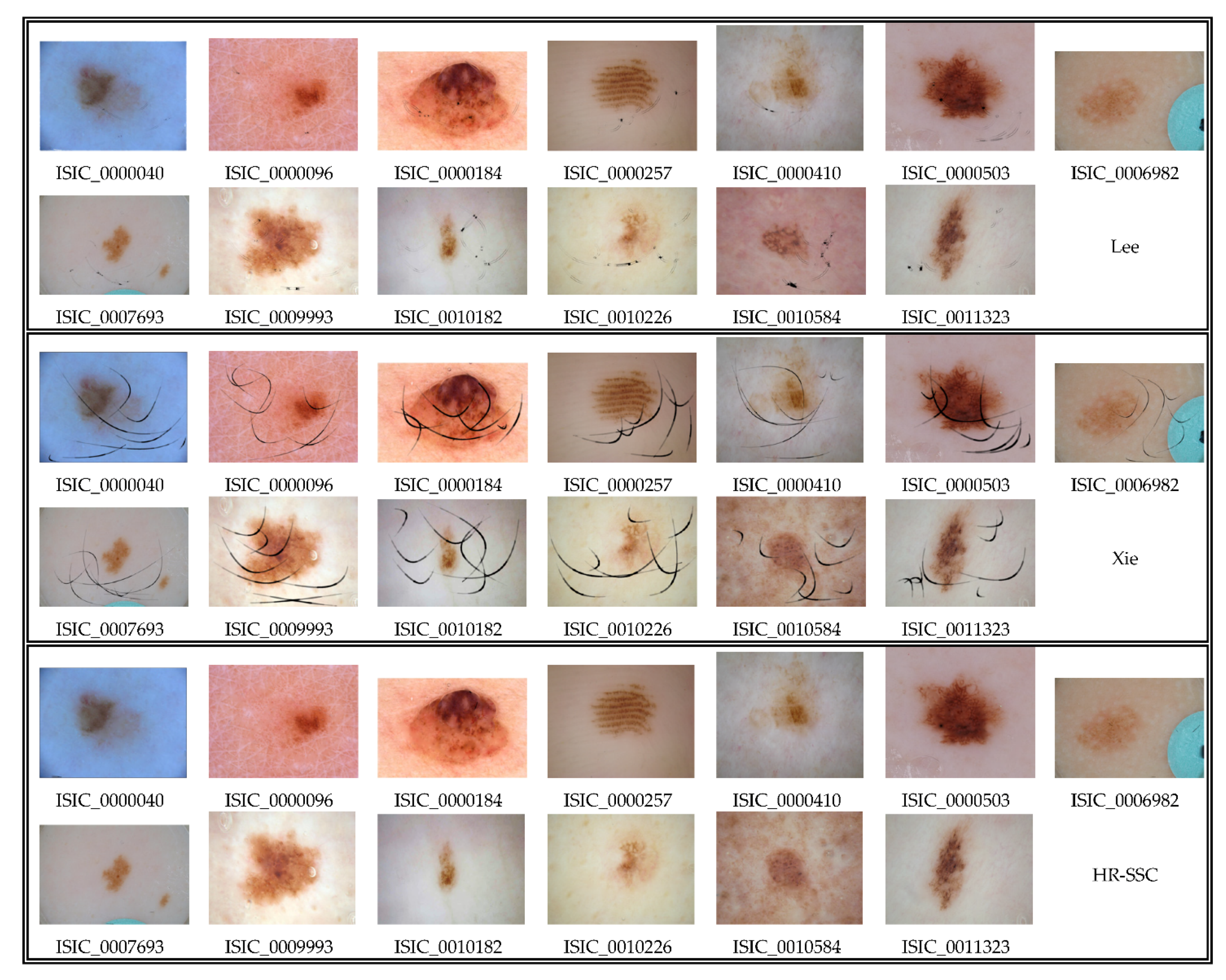
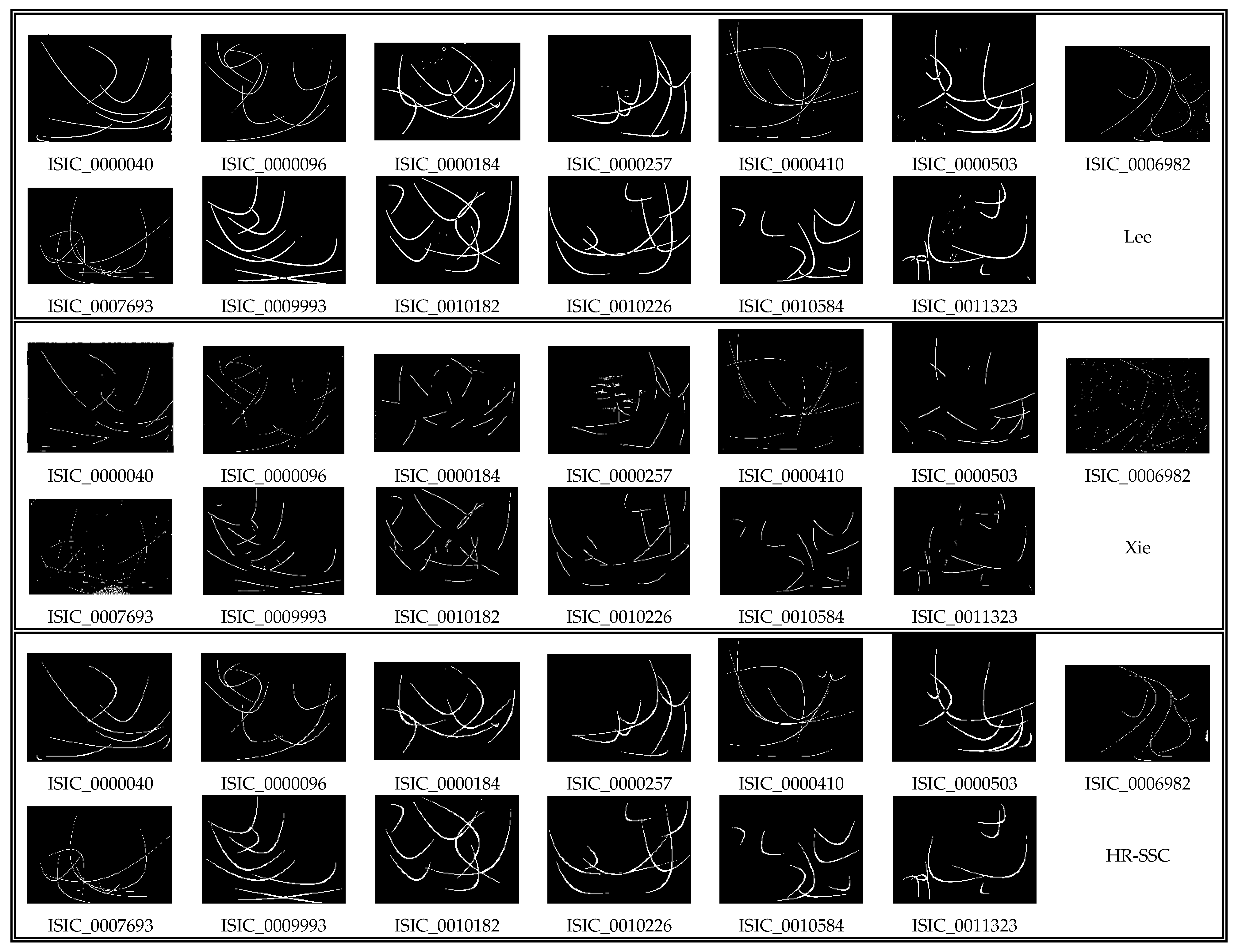
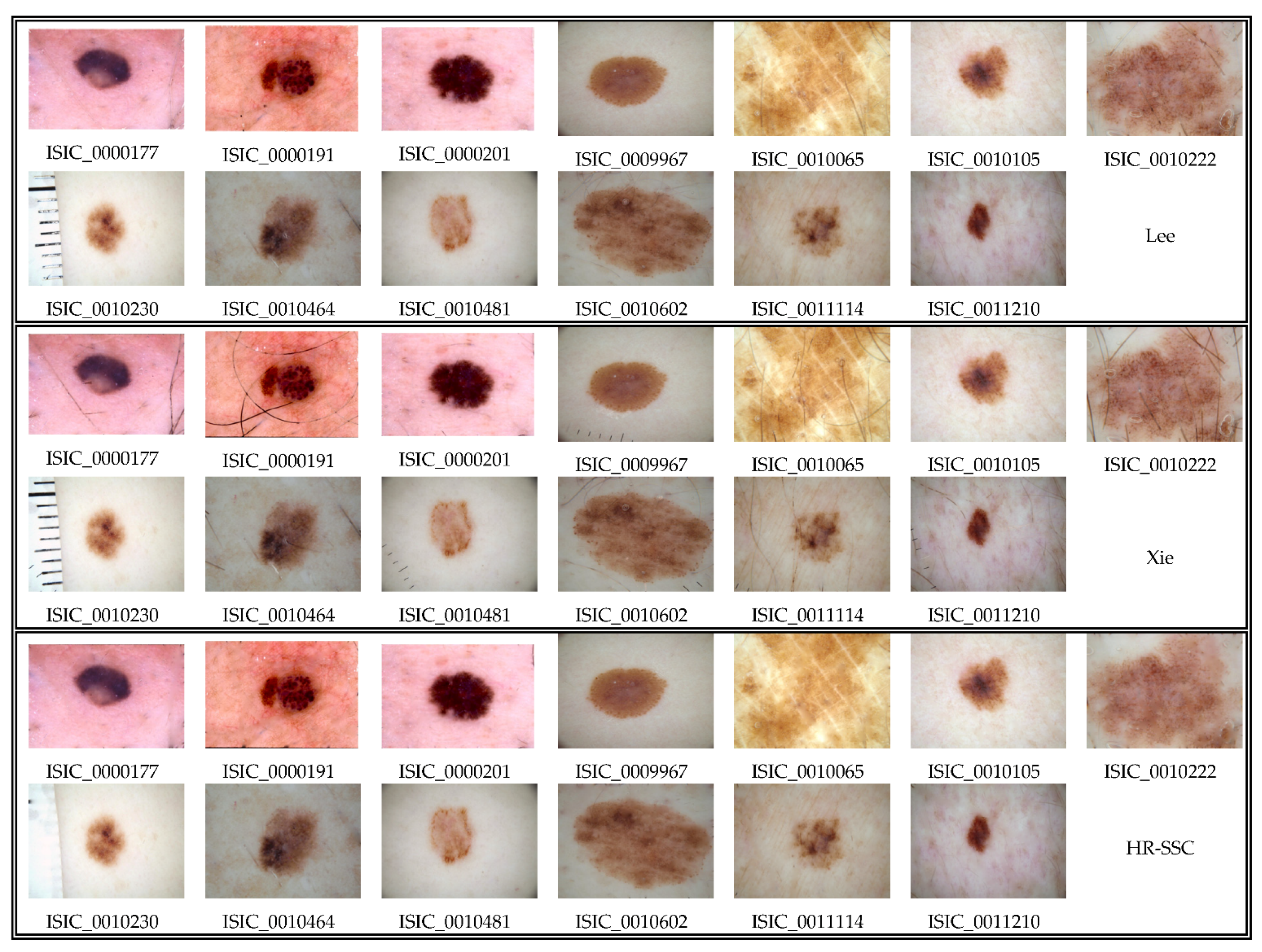
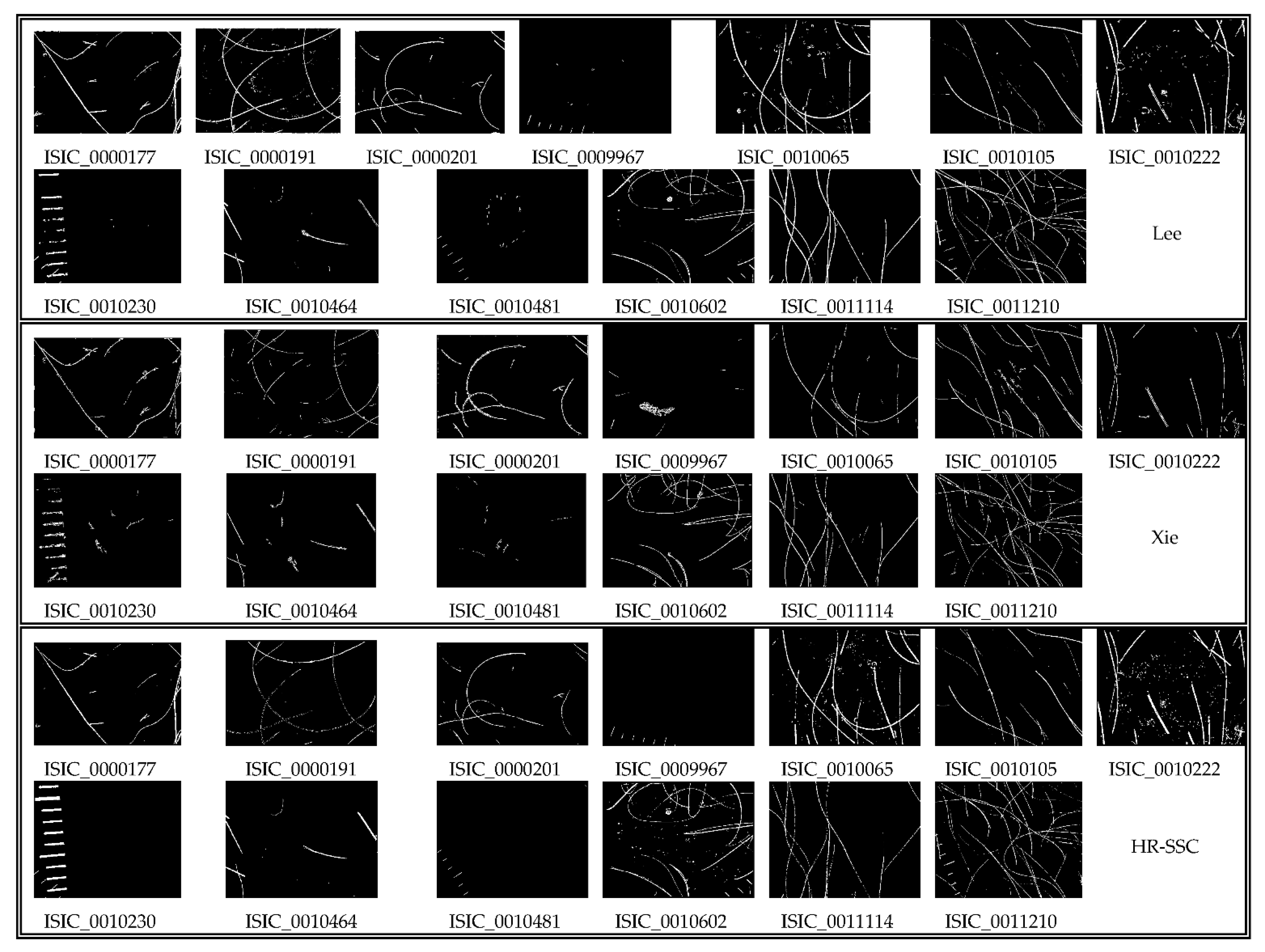
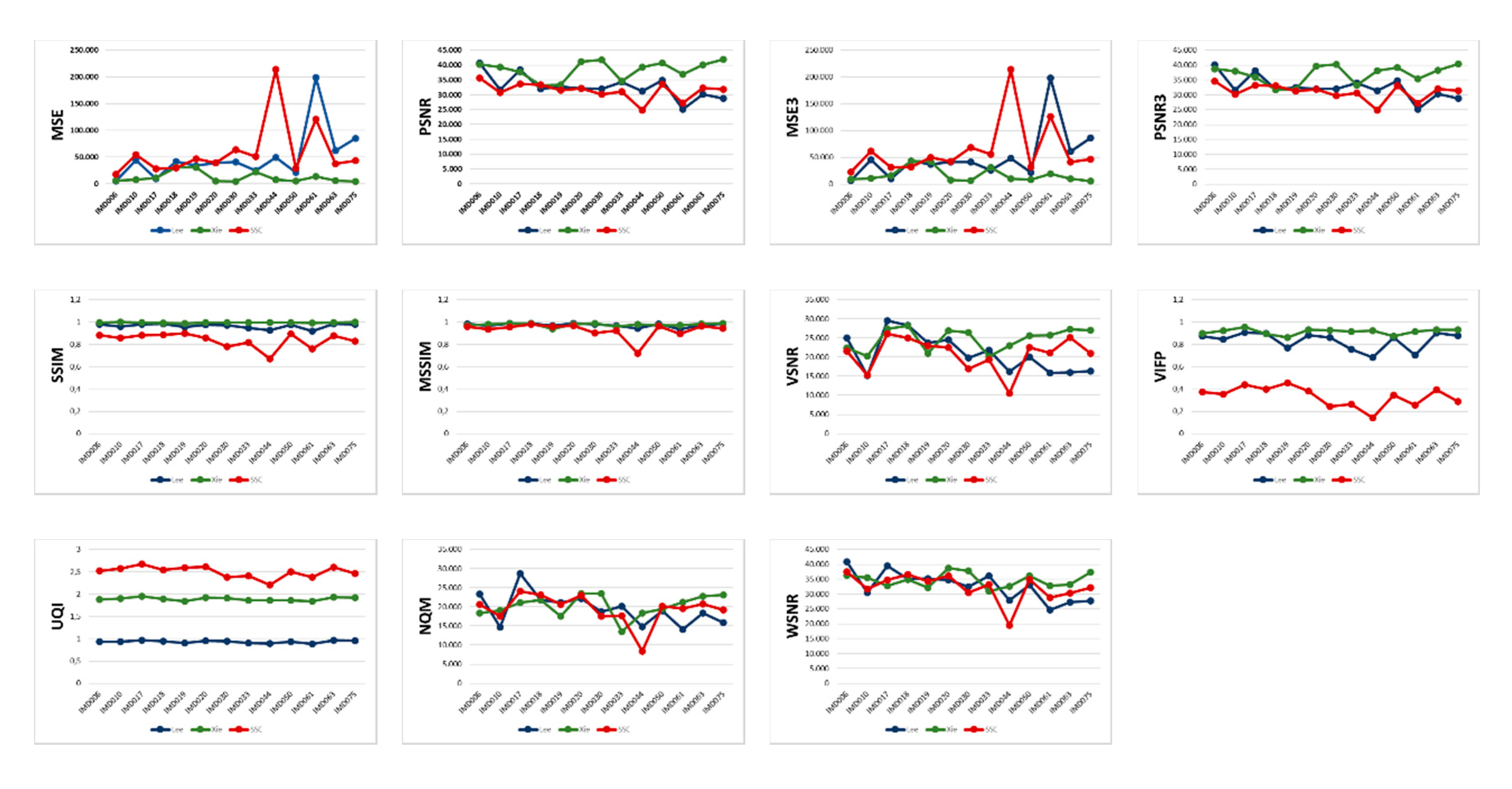
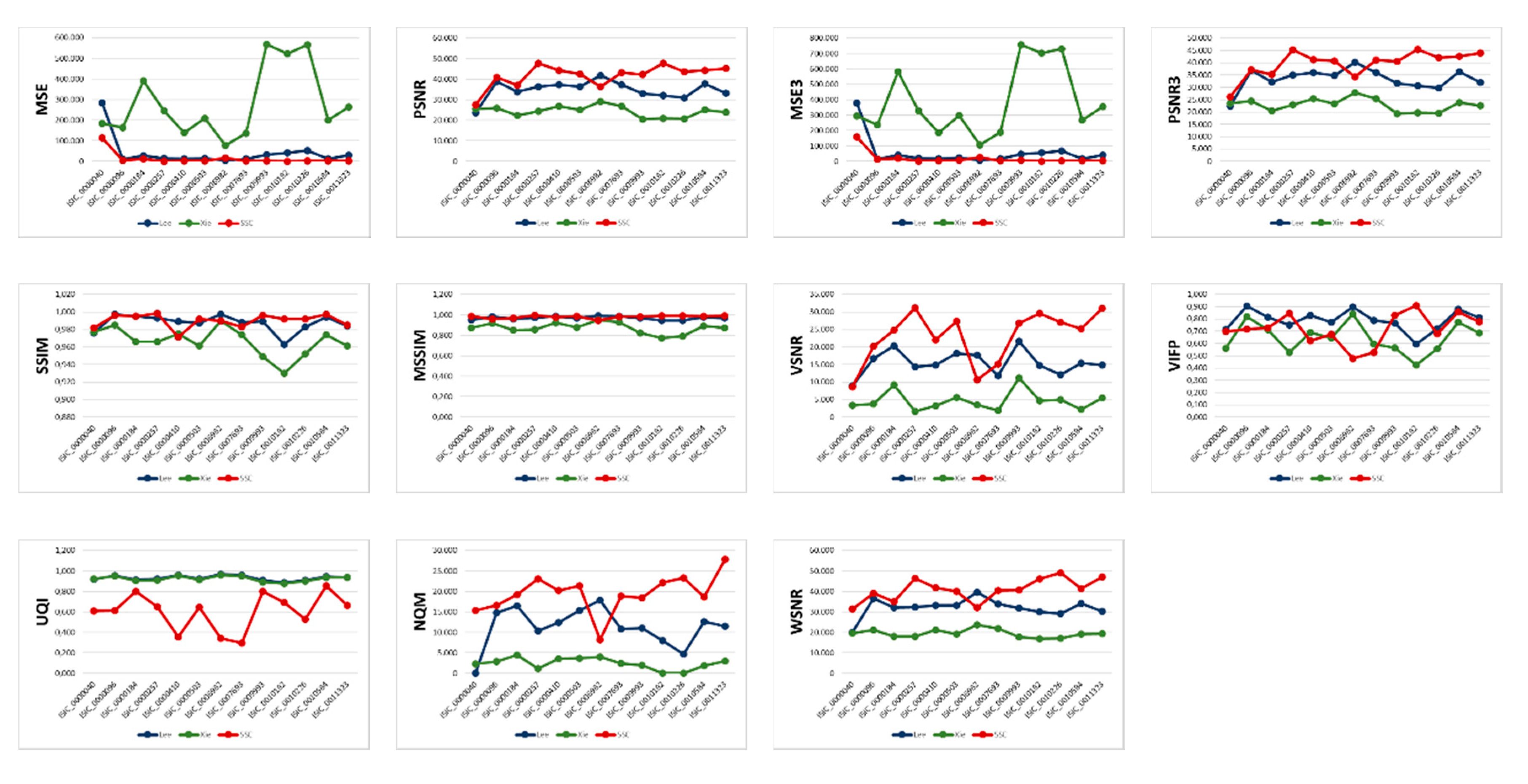
| Img | Met. | MSE | PSNR | MSE3 | PSNR3 | SSIM | MSSIM | VSNR | VIFP | UQI | NQM | WSNR |
|---|---|---|---|---|---|---|---|---|---|---|---|---|
| IMD006 | Lee | 13.626 | 36.787 | 20.918 | 34.926 | 0.888 | 0.956 | 24.401 | 0.403 | 0.650 | 23.151 | 40.255 |
| Xie | 12.610 | 37.124 | 19.831 | 35.157 | 0.891 | 0.957 | 25.355 | 0.412 | 0.653 | 22.687 | 40.286 | |
| Abbas | 57.555 | 30.530 | 64.073 | 30.064 | 0.856 | 0.898 | 15.260 | 0.354 | 0.608 | 12.372 | 28.927 | |
| Huang | 24.283 | 34.278 | 33.481 | 32.883 | 0.860 | 0.926 | 19.601 | 0.301 | 0.534 | 16.305 | 33.955 | |
| Toossi | 55.748 | 30.668 | 62.440 | 30.176 | 0.853 | 0.897 | 15.370 | 0.342 | 0.591 | 12.586 | 29.143 | |
| Bibiloni | 19.653 | 35.197 | 28.070 | 33.648 | 0.867 | 0.943 | 21.588 | 0.328 | 0.589 | 19.411 | 36.740 | |
| HR-SSC | 19.669 | 35.193 | 27.078 | 33.805 | 0.861 | 0.941 | 21.101 | 0.323 | 0.561 | 20.950 | 37.581 | |
| IMD010 | Lee | 44.373 | 31.660 | 52.734 | 30.910 | 0.855 | 0.939 | 16.990 | 0.352 | 0.659 | 18.189 | 33.261 |
| Xie | 46.305 | 31.475 | 55.898 | 30.657 | 0.859 | 0.931 | 15.853 | 0.364 | 0.665 | 14.288 | 30.576 | |
| Abbas | 88.070 | 28.683 | 98.376 | 28.202 | 0.838 | 0.907 | 14.944 | 0.330 | 0.636 | 14.129 | 28.725 | |
| Huang | 42.985 | 31.798 | 52.674 | 30.915 | 0.818 | 0.905 | 17.330 | 0.236 | 0.510 | 17.169 | 32.186 | |
| Toossi | 90.161 | 28.581 | 100.956 | 28.089 | 0.832 | 0.905 | 15.007 | 0.320 | 0.618 | 13.841 | 28.495 | |
| Bibiloni | 40.550 | 32.051 | 51.019 | 31.054 | 0.857 | 0.937 | 16.699 | 0.354 | 0.660 | 16.755 | 32.390 | |
| HR-SSC | 55.952 | 30.653 | 66.185 | 29.923 | 0.827 | 0.920 | 15.203 | 0.293 | 0.579 | 17.837 | 31.972 | |
| IMD017 | Lee | 18.625 | 35.430 | 24.645 | 34.213 | 0.881 | 0.957 | 29.130 | 0.445 | 0.711 | 27.359 | 38.837 |
| Xie | 16.228 | 36.028 | 22.790 | 34.553 | 0.884 | 0.955 | 30.411 | 0.455 | 0.714 | 25.465 | 38.191 | |
| Abbas | 61.528 | 30.240 | 67.983 | 29.807 | 0.847 | 0.911 | 21.698 | 0.390 | 0.662 | 17.373 | 28.555 | |
| Huang | 29.318 | 33.459 | 35.611 | 32.615 | 0.854 | 0.937 | 25.118 | 0.366 | 0.601 | 20.446 | 32.682 | |
| Toossi | 62.801 | 30.151 | 68.982 | 29.743 | 0.840 | 0.907 | 21.591 | 0.374 | 0.636 | 17.371 | 28.516 | |
| Bibiloni | 24.312 | 34.273 | 30.787 | 33.247 | 0.867 | 0.948 | 26.935 | 0.406 | 0.684 | 23.497 | 35.660 | |
| HR-SSC | 31.007 | 33.216 | 36.943 | 32.455 | 0.850 | 0.934 | 25.550 | 0.371 | 0.632 | 23.808 | 34.512 | |
| IMD018 | Lee | 53.072 | 30.882 | 58.624 | 30.450 | 0.865 | 0.960 | 27.433 | 0.353 | 0.581 | 22.039 | 35.006 |
| Xie | 18.253 | 35.517 | 23.648 | 34.393 | 0.863 | 0.956 | 28.108 | 0.352 | 0.578 | 25.368 | 40.353 | |
| Abbas | 112.129 | 27.634 | 117.432 | 27.433 | 0.850 | 0.913 | 17.475 | 0.344 | 0.570 | 14.966 | 28.474 | |
| Huang | 65.664 | 29.958 | 71.773 | 29.571 | 0.845 | 0.939 | 22.471 | 0.286 | 0.476 | 18.580 | 32.252 | |
| Toossi | 108.744 | 27.767 | 113.634 | 27.576 | 0.849 | 0.915 | 17.689 | 0.340 | 0.563 | 15.181 | 28.639 | |
| Bibiloni | 54.371 | 30.777 | 60.419 | 30.319 | 0.861 | 0.957 | 26.734 | 0.343 | 0.574 | 21.670 | 34.753 | |
| HR-SSC | 34.432 | 32.761 | 39.240 | 32.194 | 0.853 | 0.955 | 24.135 | 0.327 | 0.537 | 22.638 | 36.055 | |
| IMD019 | Lee | 40.674 | 32.038 | 49.993 | 31.142 | 0.882 | 0.942 | 24.415 | 0.414 | 0.696 | 21.020 | 35.377 |
| Xie | 41.599 | 31.940 | 51.373 | 31.023 | 0.886 | 0.938 | 24.315 | 0.427 | 0.700 | 19.620 | 34.346 | |
| Abbas | 80.579 | 29.069 | 90.699 | 28.555 | 0.856 | 0.908 | 18.686 | 0.372 | 0.657 | 16.024 | 30.163 | |
| Huang | 60.703 | 30.299 | 71.582 | 29.583 | 0.827 | 0.904 | 20.229 | 0.273 | 0.507 | 18.011 | 32.313 | |
| Toossi | 81.503 | 29.019 | 91.594 | 28.512 | 0.846 | 0.904 | 18.662 | 0.355 | 0.634 | 16.105 | 30.222 | |
| Bibiloni | 49.196 | 31.212 | 59.452 | 30.389 | 0.868 | 0.934 | 23.136 | 0.375 | 0.672 | 19.580 | 34.043 | |
| HR-SSC | 56.414 | 30.617 | 65.961 | 29.938 | 0.858 | 0.930 | 21.562 | 0.363 | 0.642 | 18.991 | 33.110 | |
| IMD020 | Lee | 54.462 | 30.770 | 61.126 | 30.269 | 0.842 | 0.958 | 23.801 | 0.362 | 0.653 | 22.282 | 34.661 |
| Xie | 23.642 | 34.394 | 29.561 | 33.424 | 0.846 | 0.957 | 26.239 | 0.373 | 0.660 | 25.905 | 40.384 | |
| Abbas | 132.080 | 26.922 | 138.996 | 26.701 | 0.803 | 0.883 | 15.764 | 0.306 | 0.604 | 14.074 | 26.834 | |
| Huang | 62.554 | 30.168 | 69.851 | 29.689 | 0.815 | 0.936 | 21.317 | 0.303 | 0.564 | 19.108 | 32.275 | |
| Toossi | 125.759 | 27.135 | 132.544 | 26.907 | 0.796 | 0.884 | 16.111 | 0.295 | 0.581 | 14.456 | 27.197 | |
| Bibiloni | 59.850 | 30.360 | 67.234 | 29.855 | 0.828 | 0.951 | 22.518 | 0.329 | 0.630 | 20.985 | 33.649 | |
| HR-SSC | 43.098 | 31.786 | 48.657 | 31.259 | 0.817 | 0.949 | 22.203 | 0.316 | 0.590 | 23.641 | 36.222 | |
| IMD030 | Lee | 50.827 | 31.070 | 57.665 | 30.522 | 0.864 | 0.952 | 19.959 | 0.398 | 0.660 | 18.341 | 32.244 |
| Xie | 16.425 | 35.976 | 23.671 | 34.389 | 0.869 | 0.959 | 26.493 | 0.413 | 0.669 | 25.476 | 39.857 | |
| Abbas | 70.112 | 29.673 | 76.885 | 29.272 | 0.838 | 0.917 | 18.528 | 0.352 | 0.623 | 15.447 | 29.300 | |
| Huang | 50.556 | 31.093 | 57.620 | 30.525 | 0.847 | 0.941 | 20.743 | 0.347 | 0.599 | 19.632 | 32.935 | |
| Toossi | 72.517 | 29.526 | 79.211 | 29.143 | 0.830 | 0.912 | 18.330 | 0.337 | 0.600 | 15.616 | 29.428 | |
| Bibiloni | 45.920 | 31.511 | 53.062 | 30.883 | 0.855 | 0.949 | 21.692 | 0.372 | 0.647 | 19.680 | 33.360 | |
| HR-SSC | 59.202 | 30.407 | 66.783 | 29.884 | 0.786 | 0.904 | 17.204 | 0.252 | 0.468 | 19.009 | 31.509 | |
| IMD033 | Lee | 29.071 | 33.496 | 36.028 | 32.564 | 0.858 | 0.948 | 23.146 | 0.348 | 0.623 | 20.946 | 37.195 |
| Xie | 20.680 | 34.975 | 27.696 | 33.707 | 0.874 | 0.954 | 26.280 | 0.389 | 0.646 | 20.928 | 38.139 | |
| Abbas | 87.505 | 28.710 | 94.489 | 28.377 | 0.825 | 0.894 | 16.762 | 0.302 | 0.574 | 12.081 | 28.385 | |
| Huang | 33.270 | 32.910 | 40.516 | 32.055 | 0.836 | 0.926 | 21.584 | 0.280 | 0.523 | 18.372 | 34.461 | |
| Toossi | 86.218 | 28.775 | 93.278 | 28.433 | 0.815 | 0.890 | 16.783 | 0.286 | 0.547 | 12.324 | 28.584 | |
| Bibiloni | 38.722 | 32.251 | 45.577 | 31.543 | 0.839 | 0.932 | 20.980 | 0.296 | 0.588 | 18.178 | 34.092 | |
| HR-SSC | 56.659 | 30.598 | 64.342 | 30.046 | 0.785 | 0.894 | 18.590 | 0.207 | 0.451 | 16.917 | 32.624 | |
| IMD044 | Lee | 47.457 | 31.368 | 53.355 | 30.859 | 0.863 | 0.943 | 17.641 | 0.421 | 0.738 | 16.903 | 29.594 |
| Xie | 18.590 | 35.438 | 27.085 | 33.804 | 0.887 | 0.964 | 25.971 | 0.494 | 0.774 | 23.188 | 36.594 | |
| Abbas | 72.923 | 29.502 | 78.288 | 29.194 | 0.867 | 0.926 | 16.276 | 0.457 | 0.750 | 12.369 | 25.924 | |
| Huang | 105.875 | 27.883 | 110.178 | 27.710 | 0.745 | 0.835 | 12.993 | 0.210 | 0.484 | 12.174 | 23.933 | |
| Toossi | 73.452 | 29.471 | 78.674 | 29.172 | 0.859 | 0.923 | 16.110 | 0.440 | 0.736 | 12.445 | 25.910 | |
| Bibiloni | 96.722 | 28.276 | 101.895 | 28.049 | 0.763 | 0.867 | 13.711 | 0.242 | 0.561 | 13.030 | 24.693 | |
| HR-SSC | 176.341 | 25.667 | 179.590 | 25.588 | 0.673 | 0.734 | 11.356 | 0.143 | 0.345 | 9.157 | 20.718 | |
| IMD050 | Lee | 35.787 | 32.594 | 41.721 | 31.927 | 0.880 | 0.954 | 18.895 | 0.335 | 0.578 | 17.676 | 31.938 |
| Xie | 22.695 | 34.572 | 28.814 | 33.535 | 0.881 | 0.953 | 22.280 | 0.337 | 0.578 | 19.716 | 34.639 | |
| Abbas | 49.806 | 31.158 | 55.624 | 30.678 | 0.859 | 0.898 | 18.094 | 0.314 | 0.554 | 12.763 | 28.703 | |
| Huang | 22.682 | 34.574 | 29.144 | 33.485 | 0.852 | 0.932 | 22.328 | 0.232 | 0.453 | 18.434 | 34.242 | |
| Toossi | 49.658 | 31.171 | 55.452 | 30.692 | 0.856 | 0.897 | 18.151 | 0.300 | 0.536 | 12.899 | 28.805 | |
| Bibiloni | 24.683 | 34.207 | 30.624 | 33.270 | 0.876 | 0.949 | 20.898 | 0.335 | 0.575 | 19.338 | 33.924 | |
| HR-SSC | 32.032 | 33.075 | 38.428 | 32.284 | 0.863 | 0.944 | 21.815 | 0.269 | 0.507 | 19.705 | 34.589 | |
| IMD061 | Lee | 200.137 | 25.118 | 206.683 | 24.978 | 0.818 | 0.913 | 16.492 | 0.340 | 0.655 | 14.269 | 24.901 |
| Xie | 31.045 | 33.211 | 39.240 | 32.194 | 0.853 | 0.947 | 28.493 | 0.401 | 0.701 | 24.189 | 35.438 | |
| Abbas | 162.905 | 26.011 | 170.740 | 25.807 | 0.774 | 0.862 | 19.898 | 0.262 | 0.585 | 17.621 | 27.216 | |
| Huang | 118.122 | 27.408 | 125.806 | 27.134 | 0.824 | 0.930 | 19.472 | 0.341 | 0.641 | 18.026 | 28.664 | |
| Toossi | 160.195 | 26.084 | 168.469 | 25.866 | 0.759 | 0.856 | 19.691 | 0.248 | 0.552 | 17.752 | 27.250 | |
| Bibiloni | 132.368 | 26.913 | 139.485 | 26.686 | 0.816 | 0.918 | 18.707 | 0.319 | 0.651 | 15.911 | 26.804 | |
| HR-SSC | 123.964 | 27.198 | 132.643 | 26.904 | 0.730 | 0.877 | 21.104 | 0.222 | 0.459 | 19.312 | 28.617 | |
| IMD063 | Lee | 73.087 | 29.492 | 78.056 | 29.207 | 0.868 | 0.949 | 16.458 | 0.395 | 0.638 | 18.376 | 27.193 |
| Xie | 15.333 | 36.274 | 23.189 | 34.478 | 0.871 | 0.955 | 30.726 | 0.405 | 0.644 | 27.486 | 38.241 | |
| Abbas | 75.404 | 29.357 | 82.451 | 28.969 | 0.849 | 0.914 | 19.238 | 0.372 | 0.619 | 16.239 | 25.970 | |
| Huang | 82.506 | 28.966 | 87.606 | 28.705 | 0.846 | 0.931 | 15.781 | 0.328 | 0.563 | 16.786 | 25.992 | |
| Toossi | 74.619 | 29.402 | 81.598 | 29.014 | 0.847 | 0.914 | 19.316 | 0.364 | 0.608 | 16.268 | 25.989 | |
| Bibiloni | 74.387 | 29.416 | 80.223 | 29.088 | 0.861 | 0.948 | 16.314 | 0.374 | 0.626 | 18.402 | 27.149 | |
| HR-SSC | 38.011 | 32.332 | 44.806 | 31.617 | 0.852 | 0.945 | 25.076 | 0.355 | 0.586 | 21.399 | 30.795 | |
| IMD075 | Lee | 98.538 | 28.195 | 107.530 | 27.816 | 0.860 | 0.948 | 16.524 | 0.354 | 0.624 | 15.793 | 27.594 |
| Xie | 18.342 | 35.496 | 29.230 | 33.473 | 0.866 | 0.952 | 26.945 | 0.373 | 0.635 | 24.586 | 38.198 | |
| Abbas | 73.194 | 29.486 | 82.107 | 28.987 | 0.845 | 0.926 | 18.078 | 0.336 | 0.606 | 16.732 | 28.717 | |
| Huang | 112.433 | 27.622 | 122.341 | 27.255 | 0.821 | 0.917 | 15.514 | 0.251 | 0.486 | 14.620 | 26.485 | |
| Toossi | 71.889 | 29.564 | 80.600 | 29.067 | 0.841 | 0.926 | 18.156 | 0.325 | 0.590 | 16.955 | 28.867 | |
| Bibiloni | 93.923 | 28.403 | 103.663 | 27.975 | 0.855 | 0.948 | 17.089 | 0.344 | 0.618 | 15.988 | 27.807 | |
| HR-SSC | 45.132 | 31.586 | 53.234 | 30.869 | 0.814 | 0.925 | 20.687 | 0.256 | 0.491 | 19.150 | 31.981 |
| Img | Met. | MSE | PSNR | MSE3 | PSNR3 | SSIM | MSSIM | VSNR | VIFP | UQI | NQM | WSNR |
|---|---|---|---|---|---|---|---|---|---|---|---|---|
| IMD006 | Lee | 5.443 | 40.773 | 6.400 | 40.069 | 0.978 | 0.985 | 25.044 | 0.873 | 0.938 | 23.320 | 40.853 |
| Xie | 6.105 | 40.274 | 8.712 | 38.730 | 0.998 | 0.971 | 22.402 | 0.898 | 0.944 | 18.362 | 36.300 | |
| Abbas | 146.175 | 26.482 | 149.923 | 26.372 | 0.920 | 0.836 | 9.709 | 0.747 | 0.877 | 6.777 | 23.447 | |
| Huang | 14.654 | 36.471 | 17.000 | 35.826 | 0.964 | 0.971 | 20.263 | 0.817 | 0.905 | 16.575 | 34.655 | |
| Toossi | 147.390 | 26.446 | 151.565 | 26.325 | 0.913 | 0.831 | 9.707 | 0.715 | 0.857 | 6.726 | 23.421 | |
| Bibiloni | 14.087 | 36.642 | 19.991 | 35.123 | 0.937 | 0.960 | 21.615 | 0.536 | 0.830 | 18.990 | 36.561 | |
| HR-SSC | 17.983 | 35.582 | 22.252 | 34.657 | 0.882 | 0.961 | 21.630 | 0.373 | 0.637 | 20.652 | 37.497 | |
| IMD010 | Lee | 44.462 | 31.651 | 45.490 | 31.552 | 0.960 | 0.969 | 15.108 | 0.844 | 0.935 | 14.718 | 30.440 |
| Xie | 7.632 | 39.304 | 10.396 | 37.962 | 0.999 | 0.979 | 20.231 | 0.924 | 0.967 | 19.061 | 35.559 | |
| Abbas | 93.505 | 28.422 | 96.605 | 28.281 | 0.935 | 0.894 | 12.548 | 0.769 | 0.904 | 10.231 | 25.941 | |
| Huang | 21.230 | 34.861 | 22.192 | 34.669 | 0.962 | 0.967 | 20.111 | 0.819 | 0.919 | 17.995 | 33.880 | |
| Toossi | 94.868 | 28.360 | 99.195 | 28.166 | 0.926 | 0.889 | 12.520 | 0.734 | 0.882 | 10.253 | 25.956 | |
| Bibiloni | 49.427 | 31.191 | 55.047 | 30.723 | 0.973 | 0.971 | 16.917 | 0.850 | 0.953 | 14.449 | 30.158 | |
| HR-SSC | 54.625 | 30.757 | 61.890 | 30.215 | 0.856 | 0.937 | 15.234 | 0.353 | 0.666 | 17.575 | 31.736 | |
| IMD017 | Lee | 9.535 | 38.338 | 9.855 | 38.194 | 0.981 | 0.988 | 29.519 | 0.905 | 0.967 | 28.643 | 39.534 |
| Xie | 11.082 | 37.684 | 16.277 | 36.015 | 0.997 | 0.986 | 27.386 | 0.955 | 0.979 | 21.083 | 32.729 | |
| Abbas | 64.666 | 30.024 | 67.694 | 29.825 | 0.941 | 0.934 | 20.432 | 0.758 | 0.902 | 15.536 | 26.897 | |
| Huang | 13.747 | 36.749 | 14.357 | 36.560 | 0.978 | 0.986 | 26.004 | 0.896 | 0.944 | 21.100 | 33.753 | |
| Toossi | 66.238 | 29.920 | 69.393 | 29.718 | 0.930 | 0.928 | 20.432 | 0.714 | 0.871 | 15.469 | 26.880 | |
| Bibiloni | 17.438 | 35.716 | 19.820 | 35.160 | 0.950 | 0.972 | 26.695 | 0.648 | 0.904 | 23.420 | 35.196 | |
| HR-SSC | 28.231 | 33.624 | 31.105 | 33.202 | 0.881 | 0.954 | 26.097 | 0.437 | 0.727 | 24.092 | 34.710 | |
| IMD018 | Lee | 41.735 | 31.926 | 42.896 | 31.807 | 0.982 | 0.988 | 28.284 | 0.899 | 0.944 | 21.864 | 34.994 |
| Xie | 31.009 | 33.216 | 43.166 | 31.779 | 0.993 | 0.987 | 28.252 | 0.895 | 0.942 | 21.820 | 34.947 | |
| Abbas | 43.583 | 31.738 | 44.880 | 31.610 | 0.972 | 0.983 | 27.268 | 0.829 | 0.921 | 21.782 | 34.845 | |
| Huang | 41.980 | 31.900 | 43.166 | 31.779 | 0.981 | 0.987 | 28.252 | 0.895 | 0.942 | 21.820 | 34.947 | |
| Toossi | 246.045 | 24.221 | 251.091 | 24.132 | 0.936 | 0.831 | 11.292 | 0.841 | 0.911 | 9.424 | 23.138 | |
| Bibiloni | 44.101 | 31.686 | 45.648 | 31.537 | 0.972 | 0.983 | 27.226 | 0.792 | 0.930 | 21.523 | 34.748 | |
| HR-SSC | 29.831 | 33.384 | 31.740 | 33.115 | 0.886 | 0.978 | 25.032 | 0.396 | 0.652 | 23.172 | 36.610 | |
| IMD019 | Lee | 34.227 | 32.787 | 37.125 | 32.434 | 0.954 | 0.968 | 23.690 | 0.770 | 0.908 | 21.101 | 35.203 |
| Xie | 30.434 | 33.297 | 42.538 | 31.843 | 0.986 | 0.939 | 21.001 | 0.863 | 0.930 | 17.517 | 32.120 | |
| Abbas | 311.608 | 23.195 | 326.342 | 22.994 | 0.888 | 0.797 | 10.687 | 0.636 | 0.835 | 8.627 | 22.541 | |
| Huang | 44.906 | 31.608 | 47.752 | 31.341 | 0.945 | 0.960 | 20.896 | 0.739 | 0.874 | 17.755 | 32.540 | |
| Toossi | 314.691 | 23.152 | 330.173 | 22.943 | 0.873 | 0.790 | 10.693 | 0.587 | 0.799 | 8.581 | 22.515 | |
| Bibiloni | 51.861 | 30.982 | 56.227 | 30.631 | 0.921 | 0.946 | 21.807 | 0.561 | 0.846 | 18.834 | 32.594 | |
| HR-SSC | 46.419 | 31.464 | 49.458 | 31.188 | 0.897 | 0.960 | 22.956 | 0.454 | 0.754 | 20.611 | 34.265 | |
| IMD020 | Lee | 39.130 | 32.206 | 41.418 | 31.959 | 0.974 | 0.988 | 24.516 | 0.883 | 0.951 | 22.135 | 34.724 |
| Xie | 5.025 | 41.120 | 7.099 | 39.619 | 0.998 | 0.981 | 26.952 | 0.933 | 0.965 | 23.517 | 38.794 | |
| Abbas | 151.333 | 26.331 | 157.032 | 26.171 | 0.919 | 0.864 | 13.518 | 0.709 | 0.879 | 11.620 | 24.574 | |
| Huang | 40.210 | 32.087 | 42.343 | 31.863 | 0.976 | 0.986 | 23.483 | 0.900 | 0.947 | 19.376 | 32.999 | |
| Toossi | 157.470 | 26.159 | 163.807 | 25.987 | 0.905 | 0.859 | 13.468 | 0.661 | 0.848 | 11.482 | 24.465 | |
| Bibiloni | 46.316 | 31.474 | 49.423 | 31.192 | 0.956 | 0.978 | 22.775 | 0.695 | 0.922 | 20.401 | 33.376 | |
| HR-SSC | 39.242 | 32.193 | 41.779 | 31.921 | 0.857 | 0.967 | 22.515 | 0.383 | 0.693 | 22.956 | 36.159 | |
| IMD030 | Lee | 40.468 | 32.060 | 40.968 | 32.006 | 0.970 | 0.979 | 19.777 | 0.861 | 0.945 | 18.713 | 32.452 |
| Xie | 4.286 | 41.810 | 6.163 | 40.233 | 0.998 | 0.987 | 26.467 | 0.927 | 0.969 | 23.432 | 37.889 | |
| Abbas | 81.085 | 29.041 | 83.086 | 28.936 | 0.938 | 0.915 | 16.712 | 0.743 | 0.897 | 12.585 | 26.889 | |
| Huang | 36.536 | 32.504 | 36.838 | 32.468 | 0.982 | 0.986 | 21.820 | 0.911 | 0.960 | 20.087 | 33.643 | |
| Toossi | 84.981 | 28.838 | 87.182 | 28.727 | 0.925 | 0.908 | 16.518 | 0.697 | 0.867 | 12.657 | 26.939 | |
| Bibiloni | 36.763 | 32.477 | 39.569 | 32.157 | 0.954 | 0.971 | 21.777 | 0.675 | 0.913 | 19.905 | 33.500 | |
| HR-SSC | 63.601 | 30.096 | 68.802 | 29.755 | 0.782 | 0.901 | 16.937 | 0.245 | 0.462 | 17.583 | 30.554 | |
| IMD033 | Lee | 24.454 | 34.247 | 26.046 | 33.973 | 0.947 | 0.968 | 21.830 | 0.757 | 0.907 | 20.112 | 36.196 |
| Xie | 22.402 | 34.628 | 31.323 | 33.172 | 0.995 | 0.958 | 20.109 | 0.915 | 0.952 | 13.498 | 30.916 | |
| Abbas | 189.799 | 25.348 | 194.689 | 25.237 | 0.901 | 0.855 | 12.471 | 0.662 | 0.853 | 6.665 | 23.295 | |
| Huang | 18.819 | 35.385 | 19.675 | 35.192 | 0.956 | 0.966 | 22.401 | 0.828 | 0.918 | 18.761 | 35.305 | |
| Toossi | 169.486 | 25.839 | 174.635 | 25.709 | 0.890 | 0.852 | 12.952 | 0.624 | 0.823 | 7.391 | 23.923 | |
| Bibiloni | 69.269 | 29.725 | 73.560 | 29.464 | 0.902 | 0.910 | 16.689 | 0.466 | 0.815 | 11.935 | 28.549 | |
| HR-SSC | 50.811 | 31.071 | 55.613 | 30.679 | 0.816 | 0.921 | 19.280 | 0.264 | 0.552 | 17.666 | 33.302 | |
| IMD044 | Lee | 49.270 | 31.205 | 47.786 | 31.338 | 0.927 | 0.943 | 16.197 | 0.684 | 0.890 | 14.864 | 27.824 |
| Xie | 7.508 | 39.376 | 10.183 | 38.052 | 0.998 | 0.980 | 23.052 | 0.924 | 0.973 | 18.344 | 32.600 | |
| Abbas | 39.651 | 32.148 | 39.209 | 32.197 | 0.955 | 0.945 | 17.653 | 0.790 | 0.934 | 13.447 | 27.293 | |
| Huang | 73.354 | 29.477 | 71.510 | 29.587 | 0.891 | 0.901 | 14.120 | 0.594 | 0.813 | 12.372 | 25.252 | |
| Toossi | 44.653 | 31.632 | 44.317 | 31.665 | 0.941 | 0.938 | 17.253 | 0.734 | 0.911 | 13.250 | 26.963 | |
| Bibiloni | 124.034 | 27.195 | 127.439 | 27.078 | 0.764 | 0.829 | 12.416 | 0.221 | 0.562 | 11.719 | 22.787 | |
| HR-SSC | 214.183 | 24.823 | 214.147 | 24.824 | 0.671 | 0.718 | 10.498 | 0.142 | 0.342 | 8.445 | 19.567 | |
| IMD050 | Lee | 21.355 | 34.836 | 21.807 | 34.745 | 0.976 | 0.984 | 20.082 | 0.860 | 0.930 | 19.013 | 33.138 |
| Xie | 5.561 | 40.680 | 7.855 | 39.179 | 0.998 | 0.970 | 25.606 | 0.874 | 0.934 | 19.433 | 36.204 | |
| Abbas | 121.210 | 27.295 | 122.357 | 27.255 | 0.930 | 0.838 | 12.242 | 0.790 | 0.895 | 7.594 | 23.528 | |
| Huang | 10.580 | 37.886 | 11.262 | 37.615 | 0.965 | 0.979 | 23.658 | 0.821 | 0.915 | 19.415 | 35.929 | |
| Toossi | 120.022 | 27.338 | 121.174 | 27.297 | 0.927 | 0.837 | 12.359 | 0.769 | 0.886 | 7.647 | 23.580 | |
| Bibiloni | 37.044 | 32.444 | 40.803 | 32.024 | 0.969 | 0.971 | 18.740 | 0.817 | 0.920 | 16.150 | 30.032 | |
| HR-SSC | 28.878 | 33.525 | 32.355 | 33.031 | 0.893 | 0.964 | 22.466 | 0.344 | 0.632 | 20.099 | 34.948 | |
| IMD061 | Lee | 199.214 | 25.138 | 197.816 | 25.168 | 0.918 | 0.934 | 15.841 | 0.705 | 0.881 | 14.097 | 24.753 |
| Xie | 13.371 | 36.869 | 18.984 | 35.347 | 0.994 | 0.973 | 25.671 | 0.915 | 0.962 | 21.197 | 32.801 | |
| Abbas | 231.503 | 24.485 | 238.370 | 24.358 | 0.869 | 0.848 | 17.243 | 0.568 | 0.811 | 12.035 | 22.788 | |
| Huang | 92.491 | 28.470 | 92.932 | 28.449 | 0.965 | 0.979 | 19.645 | 0.871 | 0.939 | 17.979 | 28.910 | |
| Toossi | 230.406 | 24.506 | 237.676 | 24.371 | 0.853 | 0.839 | 17.117 | 0.526 | 0.778 | 11.960 | 22.729 | |
| Bibiloni | 125.200 | 27.155 | 127.409 | 27.079 | 0.919 | 0.937 | 18.203 | 0.551 | 0.875 | 15.407 | 26.464 | |
| HR-SSC | 120.609 | 27.317 | 126.001 | 27.127 | 0.760 | 0.895 | 21.122 | 0.254 | 0.535 | 19.579 | 28.808 | |
| IMD063 | Lee | 62.239 | 30.190 | 60.750 | 30.295 | 0.984 | 0.977 | 16.040 | 0.902 | 0.959 | 18.381 | 27.253 |
| Xie | 6.407 | 40.064 | 9.620 | 38.299 | 0.996 | 0.982 | 27.252 | 0.931 | 0.968 | 22.772 | 33.216 | |
| Abbas | 88.233 | 28.674 | 89.376 | 28.619 | 0.961 | 0.937 | 15.611 | 0.820 | 0.927 | 14.729 | 24.462 | |
| Huang | 67.139 | 29.861 | 65.432 | 29.973 | 0.975 | 0.975 | 15.731 | 0.871 | 0.937 | 16.992 | 26.398 | |
| Toossi | 94.791 | 28.363 | 95.625 | 28.325 | 0.954 | 0.934 | 15.164 | 0.784 | 0.909 | 14.397 | 24.068 | |
| Bibiloni | 63.394 | 30.110 | 63.387 | 30.111 | 0.972 | 0.977 | 16.033 | 0.778 | 0.937 | 18.206 | 27.103 | |
| HR-SSC | 37.731 | 32.364 | 41.061 | 31.997 | 0.880 | 0.963 | 25.120 | 0.395 | 0.671 | 20.784 | 30.350 | |
| IMD075 | Lee | 84.834 | 28.845 | 86.173 | 28.777 | 0.979 | 0.983 | 16.386 | 0.880 | 0.951 | 15.894 | 27.734 |
| Xie | 4.125 | 41.977 | 5.986 | 40.359 | 0.999 | 0.986 | 27.081 | 0.932 | 0.969 | 23.102 | 37.372 | |
| Abbas | 123.562 | 27.212 | 123.997 | 27.197 | 0.951 | 0.917 | 14.234 | 0.803 | 0.920 | 11.946 | 24.537 | |
| Huang | 92.738 | 28.458 | 93.963 | 28.401 | 0.970 | 0.977 | 15.607 | 0.851 | 0.934 | 14.744 | 26.916 | |
| Toossi | 131.867 | 26.929 | 132.950 | 26.894 | 0.942 | 0.913 | 13.898 | 0.762 | 0.897 | 11.703 | 24.251 | |
| Bibiloni | 77.560 | 29.234 | 79.014 | 29.154 | 0.976 | 0.982 | 16.953 | 0.825 | 0.949 | 16.059 | 28.034 | |
| HR-SSC | 42.993 | 31.797 | 46.676 | 31.440 | 0.829 | 0.944 | 21.012 | 0.286 | 0.539 | 19.158 | 32.117 |
| Img | Met. | MSE | PSNR | MSE3 | PSNR3 | SSIM | MSSIM | VSNR | VIFP | UQI | NQM | WSNR |
|---|---|---|---|---|---|---|---|---|---|---|---|---|
| ISIC_0000040 | Lee | 284.167 | 23.595 | 378.463 | 22.351 | 0.976 | 0.952 | 8.877 | 0.712 | 0.916 | 0.702 | 19.995 |
| Xie | 184.397 | 25.473 | 295.277 | 23.429 | 0.977 | 0.874 | 3.327 | 0.562 | 0.923 | 2.318 | 19.575 | |
| HR-SSC | 114.313 | 27.550 | 158.448 | 26.132 | 0.982 | 0.985 | 8.688 | 0.697 | 0.611 | 15.389 | 31.447 | |
| ISIC_0000096 | Lee | 8.604 | 38.784 | 13.237 | 36.913 | 0.997 | 0.983 | 16.692 | 0.905 | 0.956 | 14.830 | 36.493 |
| Xie | 164.330 | 25.974 | 236.750 | 24.388 | 0.985 | 0.917 | 3.736 | 0.818 | 0.950 | 2.842 | 21.224 | |
| HR-SSC | 5.160 | 41.005 | 12.589 | 37.131 | 0.996 | 0.961 | 20.198 | 0.716 | 0.614 | 16.606 | 39.021 | |
| ISIC_0000184 | Lee | 26.720 | 33.862 | 39.355 | 32.181 | 0.995 | 0.959 | 20.266 | 0.815 | 0.915 | 16.444 | 31.995 |
| Xie | 391.069 | 22.208 | 580.441 | 20.493 | 0.966 | 0.848 | 9.115 | 0.711 | 0.903 | 4.434 | 17.907 | |
| HR-SSC | 12.844 | 37.044 | 19.339 | 35.267 | 0.995 | 0.966 | 24.759 | 0.728 | 0.801 | 19.208 | 34.899 | |
| ISIC_0000257 | Lee | 14.885 | 36.403 | 20.021 | 35.116 | 0.993 | 0.974 | 14.336 | 0.750 | 0.922 | 10.323 | 32.190 |
| Xie | 244.908 | 24.241 | 326.325 | 22.994 | 0.966 | 0.854 | 1.574 | 0.528 | 0.911 | 1.219 | 17.999 | |
| HR-SSC | 1.094 | 47.739 | 1.910 | 45.320 | 0.998 | 0.994 | 31.166 | 0.845 | 0.652 | 23.113 | 46.466 | |
| ISIC_0000410 | Lee | 11.893 | 37.378 | 16.306 | 36.007 | 0.989 | 0.986 | 14.863 | 0.831 | 0.957 | 12.455 | 33.225 |
| Xie | 138.029 | 26.731 | 186.638 | 25.421 | 0.975 | 0.923 | 3.274 | 0.690 | 0.953 | 3.516 | 21.231 | |
| HR-SSC | 2.346 | 44.427 | 4.869 | 41.257 | 0.971 | 0.976 | 22.008 | 0.620 | 0.354 | 20.210 | 41.823 | |
| ISIC_0010503 | Lee | 14.655 | 36.471 | 21.322 | 34.843 | 0.987 | 0.970 | 18.175 | 0.771 | 0.923 | 15.295 | 33.283 |
| Xie | 209.160 | 24.926 | 297.527 | 23.396 | 0.961 | 0.877 | 5.627 | 0.644 | 0.913 | 3.655 | 19.156 | |
| HR-SSC | 3.716 | 42.430 | 5.489 | 40.736 | 0.992 | 0.987 | 27.291 | 0.673 | 0.646 | 21.392 | 39.927 | |
| ISIC_0006982 | Lee | 4.379 | 41.717 | 6.318 | 40.125 | 0.997 | 0.991 | 17.597 | 0.896 | 0.968 | 17.799 | 39.600 |
| Xie | 78.818 | 29.165 | 106.018 | 27.877 | 0.990 | 0.950 | 3.448 | 0.840 | 0.957 | 4.028 | 23.575 | |
| HR-SSC | 15.341 | 36.272 | 23.827 | 34.360 | 0.990 | 0.947 | 10.670 | 0.479 | 0.342 | 8.234 | 32.009 | |
| ISIC_0007693 | Lee | 11.965 | 37.352 | 16.412 | 35.979 | 0.988 | 0.986 | 11.822 | 0.786 | 0.959 | 10.848 | 33.922 |
| Xie | 137.389 | 26.751 | 187.715 | 25.396 | 0.974 | 0.926 | 1.848 | 0.595 | 0.949 | 2.385 | 21.840 | |
| HR-SSC | 3.157 | 43.138 | 4.986 | 41.153 | 0.983 | 0.981 | 15.156 | 0.527 | 0.298 | 18.922 | 40.392 | |
| ISIC_0009993 | Lee | 33.238 | 32.914 | 44.902 | 31.608 | 0.989 | 0.969 | 21.622 | 0.765 | 0.909 | 10.981 | 31.791 |
| Xie | 567.510 | 20.591 | 757.976 | 19.334 | 0.949 | 0.823 | 11.120 | 0.566 | 0.890 | 1.901 | 17.733 | |
| HR-SSC | 3.807 | 42.325 | 5.871 | 40.444 | 0.996 | 0.983 | 26.823 | 0.831 | 0.801 | 18.435 | 40.775 | |
| ISIC_0010182 | Lee | 41.090 | 31.993 | 55.472 | 30.690 | 0.963 | 0.947 | 14.732 | 0.596 | 0.885 | 7.949 | 29.978 |
| Xie | 523.315 | 20.943 | 703.673 | 19.657 | 0.930 | 0.771 | 4.603 | 0.423 | 0.879 | 0.568 | 16.851 | |
| HR-SSC | 1.097 | 47.727 | 1.875 | 45.401 | 0.992 | 0.992 | 29.604 | 0.909 | 0.690 | 22.147 | 46.114 | |
| ISIC_0010226 | Lee | 52.791 | 30.905 | 68.491 | 29.774 | 0.983 | 0.945 | 12.075 | 0.719 | 0.908 | 4.659 | 29.058 |
| Xie | 565.808 | 20.604 | 729.467 | 19.501 | 0.952 | 0.791 | 4.894 | 0.556 | 0.898 | 0.354 | 17.064 | |
| HR-SSC | 2.754 | 43.731 | 4.069 | 42.035 | 0.992 | 0.989 | 27.022 | 0.680 | 0.526 | 23.257 | 49.042 | |
| ISIC_0010584 | Lee | 11.216 | 37.632 | 15.213 | 36.309 | 0.994 | 0.979 | 15.329 | 0.879 | 0.944 | 12.649 | 34.171 |
| Xie | 201.006 | 25.099 | 267.899 | 23.851 | 0.974 | 0.889 | 2.207 | 0.771 | 0.936 | 1.850 | 19.196 | |
| HR-SSC | 2.362 | 44.397 | 3.562 | 42.613 | 0.997 | 0.987 | 25.250 | 0.855 | 0.855 | 18.605 | 41.457 | |
| ISIC_0011323 | Lee | 30.361 | 33.308 | 40.709 | 32.034 | 0.984 | 0.968 | 14.807 | 0.809 | 0.938 | 11.530 | 30.180 |
| Xie | 263.791 | 23.918 | 353.511 | 22.647 | 0.961 | 0.872 | 5.395 | 0.686 | 0.935 | 3.013 | 19.455 | |
| HR-SSC | 1.922 | 45.294 | 2.683 | 43.844 | 0.985 | 0.993 | 30.951 | 0.775 | 0.666 | 27.842 | 47.033 |
| Dataset | Met. | MSE | PSNR | MSE3 | PSNR3 | SSIM | MSSIM | VSNR | VIFP | UQI | NQM | WSNR |
|---|---|---|---|---|---|---|---|---|---|---|---|---|
| H13GAN-data | Lee | 58.441 | 31.454 | 65.314 | 30.752 | 0.863 | 0.948 | 21.176 | 0.379 | 0.651 | 19.719 | 32.927 |
| Xie | 23.211 | 34.802 | 30.925 | 33.445 | 0.872 | 0.952 | 25.959 | 0.400 | 0.663 | 22.993 | 37.326 | |
| HR-SSC | 59.378 | 31.161 | 66.453 | 30.521 | 0.813 | 0.912 | 20.430 | 0.284 | 0.527 | 19.424 | 32.329 | |
| H13Sim-data | Lee | 50.490 | 32.631 | 51.118 | 32.486 | 0.964 | 0.973 | 20.947 | 0.833 | 0.931 | 19.450 | 32.700 |
| Xie | 11.919 | 38.485 | 16.792 | 36.968 | 0.996 | 0.975 | 24.728 | 0.914 | 0.958 | 20.241 | 34.727 | |
| HR-SSC | 59.626 | 31.384 | 63.298 | 31.012 | 0.838 | 0.928 | 20.762 | 0.333 | 0.605 | 19.413 | 32.356 | |
| sH13Sim-data | Lee | 41.997 | 34.793 | 56.632 | 33.379 | 0.987 | 0.970 | 15.476 | 0.787 | 0.931 | 12.147 | 31.991 |
| Xie | 282.272 | 24.356 | 386.863 | 22.953 | 0.966 | 0.870 | 4.628 | 0.645 | 0.923 | 2.833 | 19.447 | |
| HR-SSC | 13.070 | 41.775 | 19.194 | 39.669 | 0.990 | 0.980 | 23.045 | 0.718 | 0.604 | 19.489 | 40.800 | |
| HSim-data | Lee | 56.748 | 32.693 | 77.344 | 31.310 | 0.984 | 0.959 | 16.709 | 0.773 | 0.918 | 11.184 | 30.038 |
| Xie | 376.331 | 23.049 | 509.629 | 21.717 | 0.958 | 0.853 | 7.000 | 0.650 | 0.911 | 3.202 | 18.552 | |
| HR-SSC | 24.525 | 38.001 | 35.450 | 36.237 | 0.988 | 0.972 | 21.952 | 0.714 | 0.677 | 16.212 | 35.725 |
| Img | AI | AL | Ax | AR |
|---|---|---|---|---|
| ISIC_0000040 | 47,608 | 77,001 | 1,665,451 | 51,985 |
| ISIC_0000096 | 66,463 | 86,920 | 3,106,080 | 78,198 |
| ISIC_0000184 | 32,827 | 42,115 | 733,964 | 33,815 |
| ISIC_0000257 | 26,069 | 33,456 | 768,308 | 28,057 |
| ISIC_0000410 | 86,133 | 110,826 | 4,541,149 | 105,109 |
| ISIC_0000503 | 27,411 | 33,822 | 724,917 | 28,063 |
| ISIC_0006982 | 73,066 | 110,461 | 6,010,208 | 106,147 |
| ISIC_0007693 | 100,975 | 131,136 | 5,984,212 | 135,523 |
| ISIC_0009993 | 35,991 | 47,248 | 766,116 | 38,432 |
| ISIC_0010182 | 36,257 | 44,818 | 764,856 | 38,127 |
| ISIC_0010226 | 33,226 | 41,208 | 770,008 | 34,677 |
| ISIC_0010584 | 21,630 | 27,634 | 774,687 | 22,792 |
| ISIC_0011323 | 20,309 | 27,615 | 774,768 | 22,041 |
| Dataset | <AL> | <Ax> | <AR> |
|---|---|---|---|
| Hsim-data | 61,045 | 1,594,363 | 48,830 |
| Img | Met. | FDR | TDR | Img | Met. | FDR | TDR |
|---|---|---|---|---|---|---|---|
| ISIC_0000040 | Lee | 0.326 | 0.674 | ISIC_0007693 | Lee | 0.651 | 0.349 |
| Xie | 0.980 | 0.020 | Xie | 0.992 | 0.008 | ||
| HR-SSC | 0.202 | 0.798 | HR-SSC | 0.469 | 0.531 | ||
| ISIC_0000096 | Lee | 0.303 | 0.697 | ISIC_0009993 | Lee | 0.641 | 0.359 |
| Xie | 0.985 | 0.015 | Xie | 0.992 | 0.008 | ||
| HR-SSC | 0.206 | 0.794 | HR-SSC | 0.456 | 0.544 | ||
| ISIC_0000184 | Lee | 0.293 | 0.707 | ISIC_0010182 | Lee | 0.631 | 0.369 |
| Xie | 0.988 | 0.012 | Xie | 0.992 | 0.008 | ||
| HR-SSC | 0.217 | 0.783 | HR-SSC | 0.444 | 0.556 | ||
| ISIC_0000257 | Lee | 0.311 | 0.689 | ISIC_0010226 | Lee | 0.628 | 0.372 |
| Xie | 0.987 | 0.013 | Xie | 0.992 | 0.008 | ||
| HR-SSC | 0.211 | 0.789 | HR-SSC | 0.439 | 0.561 | ||
| ISIC_0000410 | Lee | 0.299 | 0.701 | ISIC_0010584 | Lee | 0.618 | 0.382 |
| Xie | 0.989 | 0.011 | Xie | 0.992 | 0.008 | ||
| HR-SSC | 0.243 | 0.757 | HR-SSC | 0.427 | 0.573 | ||
| ISIC_0000503 | Lee | 0.281 | 0.719 | ISIC_0011323 | Lee | 0.608 | 0.392 |
| Xie | 0.991 | 0.009 | Xie | 0.992 | 0.008 | ||
| HR-SSC | 0.276 | 0.724 | HR-SSC | 0.416 | 0.584 | ||
| ISIC_0006982 | Lee | 0.654 | 0.346 | ||||
| Xie | 0.992 | 0.008 | |||||
| HR-SSC | 0.464 | 0.536 |
| <FDR> | <TDR> | |
|---|---|---|
| Lee | 0.503 | 0.497 |
| Xie | 0.990 | 0.010 |
| HR-SSC | 0.360 | 0.640 |
Publisher’s Note: MDPI stays neutral with regard to jurisdictional claims in published maps and institutional affiliations. |
© 2021 by the author. Licensee MDPI, Basel, Switzerland. This article is an open access article distributed under the terms and conditions of the Creative Commons Attribution (CC BY) license (http://creativecommons.org/licenses/by/4.0/).
Share and Cite
Ramella, G. Hair Removal Combining Saliency, Shape and Color. Appl. Sci. 2021, 11, 447. https://doi.org/10.3390/app11010447
Ramella G. Hair Removal Combining Saliency, Shape and Color. Applied Sciences. 2021; 11(1):447. https://doi.org/10.3390/app11010447
Chicago/Turabian StyleRamella, Giuliana. 2021. "Hair Removal Combining Saliency, Shape and Color" Applied Sciences 11, no. 1: 447. https://doi.org/10.3390/app11010447
APA StyleRamella, G. (2021). Hair Removal Combining Saliency, Shape and Color. Applied Sciences, 11(1), 447. https://doi.org/10.3390/app11010447





